#anyway a group of us were exploring a church and i came across this statue and i was mesmerised by it ♡
Text
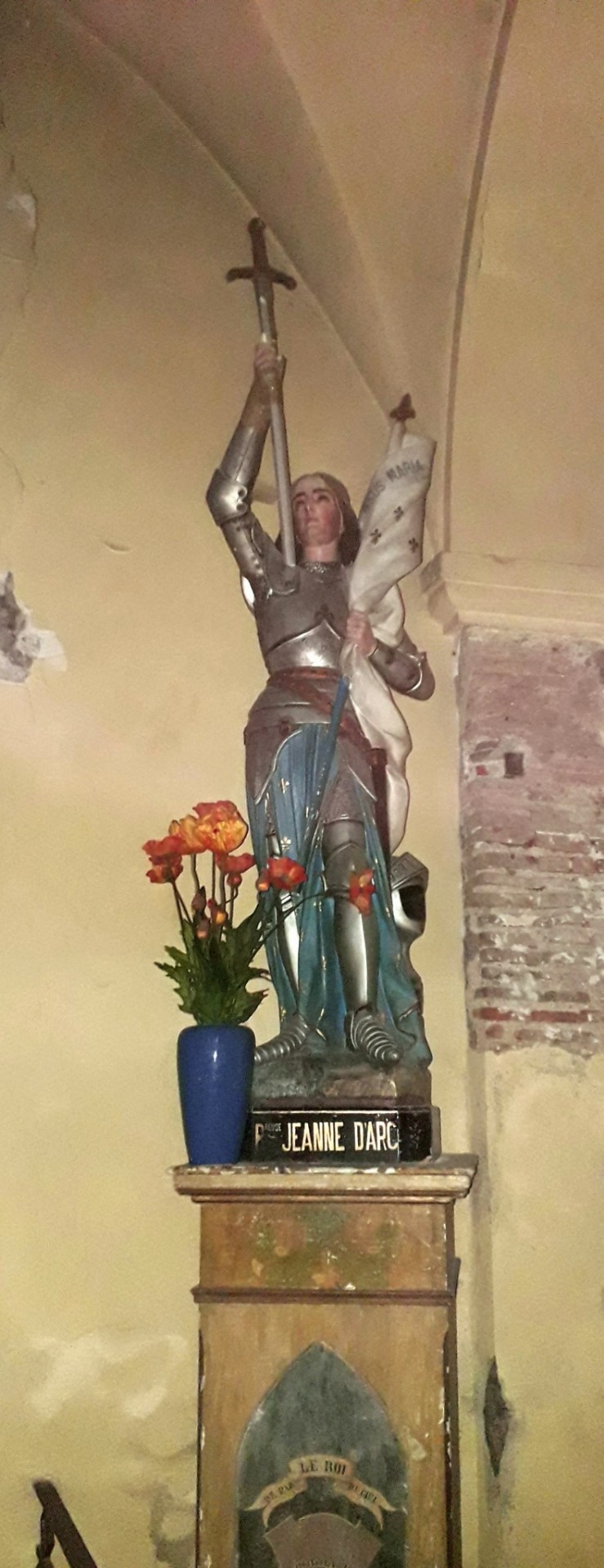
XXVI.V.MMXXII
A statue of Joan of Arc in a local church, Durfort, France
Photographed by me
#before you ask no i have no idea what the political preferences were in the area#soooo HOPEFULLY i was not in a church where fascists would attend#but she is a saint so i mean it makes sense for her to be in a church imo#if anyone knows more info do let me know x#anyway a group of us were exploring a church and i came across this statue and i was mesmerised by it ♡#i had never seen a statue of jeanne d'arc before so i thought it was wonderful#also this was on the day i got my exam results and i got the highest overall grade out of any of my college years lmao#joan of arc#jeanne d'arc#statues#the image is cropped funny bc there was a fire extinguisher right beside the statue 💀 the irony!!#i took it on my phone camera and in an area of poor lighting so it all did ✨wonders✨ for the image quality rip#so don't @ me about the image quality ik it's shitty af#my photos#captured by the cruel mistress#portraits by the siren#sculpture#statue#art#church#religious imagery
44 notes
·
View notes
Text
Sarah Rogers pt 2: or, how baby!Steve imbibed a fuck-you attitude with his mother’s milk
Okay, so after looking at Sarah’s backstory, how she met Joseph and had Steve and decided to go to America, I couldn’t stop thinking about: what next? The MCU wiki is VERY thin on the ground with detail, and she’s so interesting! Plus, this is, like, one of the most criminally underdeveloped sources for Steve Rogers’ character, as I mentioned in pt 1. So, what can we reasonably source from the time to fill in the gaps?
So: I said in my previous post Sarah likely arrives in January/February of 1918. This is because in those days, travel times were long, conditions were VERY poor and you did not want to be heavily pregnant on a cheap ship to America with the conditions on board. Plus, in those days there was no guarantee a ship company would even sell you a ticket if you were visibly pregnant. It did happen, but was risky for the company, so you could never be sure. Sarah would have left asap once she made a decision.
The journey itself would have taken about 3-4 weeks. First she would have had to travel to London, because nothing would have been leaving to America from the French or Belgian coastline, as a) most of it was too close to the war and b) the bits that weren’t wouldn’t have been profitable. Travel to London from Passchendaele would have taken a few days to a week, given the mud and absolute priority troops and military materials were given on all journeys. This map here shows it took between 7-10 days to arrive in New York from London (by ship, no flights until the late 1920s/1930s) in 1914 before the outbreak of the war. I mentioned how at this point the German U-boats were basically sinking anything they found not flying a German flag, which made this journey pretty hazardous, even with the newly introduced (and very effective) protection of the convoy system. If Sarah was travelling on a fast convoy (less likely as they were primarily for troop ships) it would have taken about a week. Slower moving convoys carrying mostly cargo might have taken 2 weeks, even 2 and a half weeks if the weather was bad. Convoys, by the way, were where groups of ships were clustered together and escorted across the Atlantic by a combination of naval ships bristling with every explosive known to man, and navy ships disguised to look like harmless merchant cargo ships but ALSO bristling with every explosive known to man, to prevent U-boats sinking them. And also attack U-boats when they turned up. Not if. When.
As you may be imagining, these journeys often contained lots of Things Going Boom and people Dying in Unpleasant Ways. Sarah would have been told by literally everyone she knew that this was a stupid, near-lethal decision, and that she should just NOT. But Sarah being Sarah, ignored this in the pursuit of what she felt was right and best for her and her baby... that doesn’t sound familiar at all, does it?
Okay, so she’s made it through the journey to the iconic Ellis Island. The next problem was that Immigration to the USA was incredibly curtailed by 1918, compared to the levels of immigration to the US prior to WWI beginning. In this, Sarah was lucky. Prior to WWI, on average between 1900-1914 about 1 million immigrants arrived into the US each year. In 1918, roughly 110,000 did - Sarah being one of them. I’ve said before that she would have had an easier time getting passage on a ship in the first place because she was comparatively better off on a nurse’s wage and was a middle class professional. More than that, most travel was reserved for the military - and Sarah likely had connections, being the wife of an American soldier, which made it easier for her to gain passage on a ship. (More on this later.)
Her status and profession is also very important for explaining how Sarah gained entry to the US, because by the end of WWI, the open door policy of the 19th and early 20th century had been solidly shut. The open-door policy had essentially allowed anyone who could pass a very basic medical and legal check free entry to reside in the USA, and the Ellis Island museum has a very good description of just how cursory these checks were - they were nicknamed the ‘six second physicals’. 98% of immigrants passed straight away, and a only a very small percentage of the remainder were put on a ship back to their country of origin. But by the outbreak of WWI, politicians and the public had become uneasy about this. Mostly due to racial concerns - Chinese immigration was the first to be restricted in 1882 with the Chinese Exclusion Act. Japanese immigrants were targeted in 1907 and all Asian immigrants in 1917. (I see a lot of posts on tumblr talking about how immigration restrictions in the US began by denying Jewish refugees entry in the 1930s, which... is wrong. So, so wrong. But anyway.) Here is a contemporary cartoon showing a pretty good summary of attitudes to immigration by the time Sarah would have been travelling:

(The 3% refers to immigration restrictions put in place by Congress AFTER the war, btw.)
But the US wasn’t just worried about one continent’s people! Or even ‘just’ non-whites! Oh no... they were also VERY worried about the ‘wrong sort’ of white immigrant too. Namely, anyone from southern and eastern Europe, and the Irish.
The discrimination against the Irish is an interesting one, because on the face of it, the Irish were the kind of immigrants the US wanted - north and western Europeans. But here’s where eugenics and pseudoscience come along and fuck things up for a lot of people. Part of the reason why the US was suspicious of southern and eastern Europeans was political - that they harboured a tendency towards violent revolutions, communism and anarchy. The Irish, after the violence of the 1916 Easter Rising and the fact that a not-insignificant number of violent revolutionaries tried to facilitate a German invasion of Ireland (and then unionists ran guns during the war through Kriegsmarine U-boat dropoffs on the Irish coast in... defence???? Idk either.), came to be included in this politically radical group. That’s the first strike.
The second strike came from the fact Irish had the British working against them. In those days, British media and culture really set the tone for the rest of the world. Remember, the US was not a world superpower yet - this is when Britain is at the height of its power, ruling 20% of the world’s people and 25% of its land surface by 1924. Britannia really did rule the waves, and much of the world’s culture, at this point. Hollywood, and American ‘soft power’ had yet to develop into the behemoth it is now. British culture persistently depicted the Irish as subhuman, ape-like, feckless, uncivilised and dangerous, as you can clearly see here:
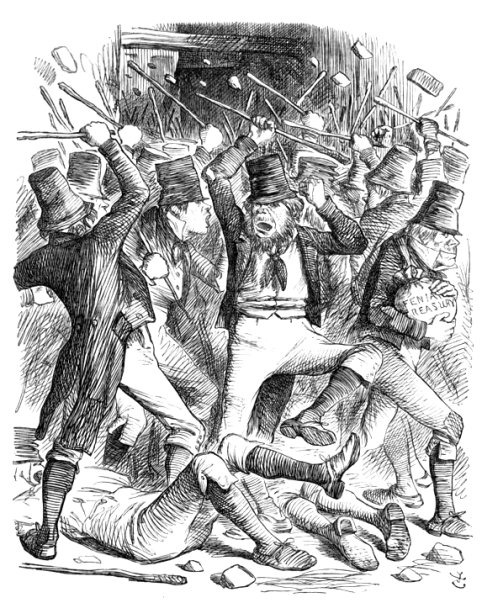

The top one is from 1866, and the second one from 1849. Both were cartoons published in Punch Magazine, which was the pre-eminent social and political publication that EVERYONE read in the Victorian and Edwardian eras. It also played a huge role in shaping social attitudes, and you can see more of its, and others, views on the Irish in these excellent galleries. The rest of the British media was the same - almost universally negative views of the Irish, which filtered across the Atlantic over time. And seemed to be vindicated by events like the 1916 Easter Rising, and before that a long running number of secret societies the British kept discovering, plotting revolution against their rule. The whole ‘kiss me I’m Irish’, dying the Hudson green on St Patrick’s day, ‘omg I love an Irish accent’ thing? Didn’t happen until the latter half, or really the last quarter, of the twentieth century. The Irish were pretty much persona non grata when Sarah was alive. Part of the explanation for this came from the idea that the Irish were a part of a lesser race, their Celtic origins leading to a lack of judgement, predisposition to alcoholism and hotheadedness, and passionate outbursts which meant you needed to treat them more like children. Conveniently enough for the British, this explanation meant you didn’t need to treat your subjects like equals, deserving of the vote, or indeed with anything except violence and condescension. Ha. Funny that.
But anyway, back to America.
Third strike: the Irish were Catholic, as Sarah would have been. Only the very richest in society were Protestant, because they were descended from British settlers. Both the British and the US governments of the time viewed Catholicism with deep suspicion, partly for historical reasons (Martin Luther, 1517 and all that jazz) but ALSO because the Catholic Church remained a vastly powerful institution which could and did command the loyalties of people more than the national government, and this represented a dangerous fifth column within the nation state. Most of north and western Europe was Protestant, unlike the south and east which was predominantly Catholic (with the exception of France. But hey, they’re the French. No big.) so the Irish being 99% Catholic was yet another reason they got lumped in with the other ‘undesireables’.
Not a small part of this was caused by the fact that the Irish had been immigrating to America in vast numbers ever since the Great Famine (aka the Potato Famine/Blight) to the tune of and average of c450,000 Irish per decade between 1850-1900. That is... a LOT. Like, New York’s population in 1890 had only just hit 2.5 million! Ireland’s population TODAY is 5 million! So by the end of WWI, there was already a sense that Too Many Irish were here, particularly since the Irish tended, like most immigrant communities, to move into certain areas in large numbers via family groups and connections. Sarah would have been no exception to this, which I’ll explore more in pt 3 later. It was a very common practice in this period for a man to go to America and work, then bring his family and extended family over. Or for young relations to go and live with family already in America if there was no work in Ireland - which there wasn’t, the Irish economy being subsistence agriculture and not a lot else.
All of this together means that when Sarah arrives in Jan/Feb of 1918? She’d get a pretty rough welcome at Ellis Island (still used for incoming immigrants until new legislation establishing a visa system in 1924 went through and basically made it redundant.) and beyond.
Below is a pic of an Ellis Island arrival card, just because it’s cool:

These tightened restrictions resulted in not just health checks, but intelligence tests and ‘mental fitness’ tests, which if failed, could result in the immigrant being sent back to their country of origin. However, Sarah would have made it through okay, because she had good English, her profession and likely her marriage cert and references from Joseph Rogers’ commanding officer to speed her passage. She may even have had family connections already in New York or America, but for the reasons outlined in my previous post, probably wasn’t in contact with them. Or if she did contact them, was likely to be ignored and ostracised. Because patriarchy, yay.
But ironically? Getting into America was the easy part. I know, I know, unbelievable, especially when you consider she was PREGNANT during this. I mean, can you imagine enduring morning sickness and all the other joys of pregnancy on a boat in the middle of the Atlantic in WINTER, in danger of sinking from a U-Boat torpedo at any moment? Can you? Can you??? Sarah Rogers came up against an immense set of obstacles just to get into America and just fucking ploughed through them like they were tissue paper. Which explains a LOT about Steve Rogers, that’s for sure.
Join me next time for pt 3, where I explore Sarah’s living and working situation after she arrives and we all learn to be even more in awe of how fucking metal she was.
#Sarah Rogers#WAS AWESOME I WILL HAVE NO DISSENT IN THE RANKS#no really#she must have been a fucking BADASS#the early 20th century was not a good time to be a woman#or irish#or pregnant#or a widow#yikes#captain america backstory#steve rogers origin#mcu#fandom meta#character development#steve rogers#wwi#ireland#emigration#america#immigration#and all the fun racism and discrimination THAT entailed
78 notes
·
View notes
Text
Three Days in Iceland
Pre-Trip
I had planned on hitting Iceland on my way to Europe for some time. It was around 2012 that I first heard of the extended layover on Icelandair, but never really thought to look much into it, at least until I had a reason to. Study abroad finally gave me that reason. Turns out you can stay up to seven days in Iceland on your way to wherever you want to go without incurring extra service fees. Combine that with relatively cheap airfare and it seemed like the easiest way to beat jetlag and see somewhere new. I figured a place like Iceland would be a little expensive, and not wanting to blow my entire wallet before I even hit Amsterdam, I decided on a three day layover. It seemed like enough time to see some of Western Iceland and maybe get a feel for the place. I made sure to pack for some outdoors: raincoat, hiking shoes, swimsuit, sweatshirts. When researching places to stay, I found my hunch about price was correct: Iceland was more than a little expensive. Staying in Reykjavik was out of the question, so instead I found a guesthouse in the village of Akranes, about 45 minutes up the road. After the quarter ended in early June, I flew to Denver to see my parents and tie up some important loose ends before my trip. On June 17, I caught my first flight from Denver International Airport and tried to sleep on the seven hour flight to Keflavik.
Day 1
Our flight was a little late getting out of Denver, so we landed at around 9:30 local time in Iceland. Running on about 3.5 hours of sleep, I got my rental car and headed straight for my 11:00 appointment at the Blue Lagoon. I was running about an hour late, of course, but they didn’t seem to mind at all. In fact, it was one of the best customer service experiences I’ve ever had. If I went down the wrong hallway, they immediately pointed me in the right direction or let me through with my wristband anyway. The sushi I had was nourishing after all that time in the air. The water was nothing short of spectacular: milky white, warm and relaxing. Two steam baths and a sauna were open and accessible in the corner and both were quite necessary. One kiosk on the left hand side sold mud masks, like the Dead Sea, and offered a silica one for free. Two rounds of the silica mask made the skin on my face feel as happy as it had been in years. Another kiosk in the corner sold beer and drinks, so I got the Icelandic national brew: Gull. Drinking and driving in Iceland is strictly forbidden, so I wanted to make sure to limit myself to only two drinks on my trip, this being one of them. I’ll get to the other one later. Gull isn’t too bad, but not too great. Something of a standard macro lager, a few shades better than Rainier. Enjoying my drink slowly allowed me to make friends with some folks around me from the Pacific Northwest, which definitely made the transition to a foreign land a little easier. My only regret from a place like this is that eventually you’ll have to leave. But I’ll be back...
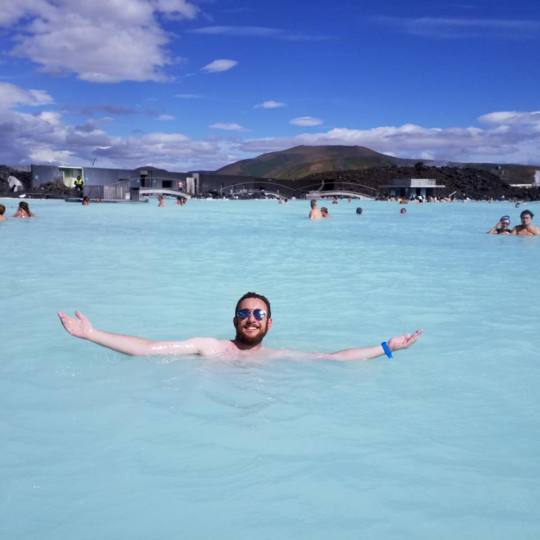
Feeling refreshed, relaxed, and sobered up from my one beer, I hopped in the car and went to Reykjavik. It’s a fairly small city: you can see much of the main areas in a day. The main landmark in the city is Halgrimskirkja: the cathedral of the Church of Iceland. It’s fairly impressive, with a really cool looking pipe organ and a statue of Leif Erikson in front. I had forgotten he was of Iceland, that his father was Erik the Red. Not far from Halgrimskirkja was the Laugevegur, the main restaurant and shopping district. It was along this street that I knew where to find my second and final drink in Iceland. Many of the hot spots along this street carried oddly American names: the Chuck Norris Grill, a pub called Boston that looked like it was taken directly out of Cheers. I finally came upon the one I wanted: Lebowskibar. It was absolutely kitsch, sure, but I’m a sucker for anything to do with The Big Lebowski. I had to have my White Russian, and a “hell of a Caucasian” it was.

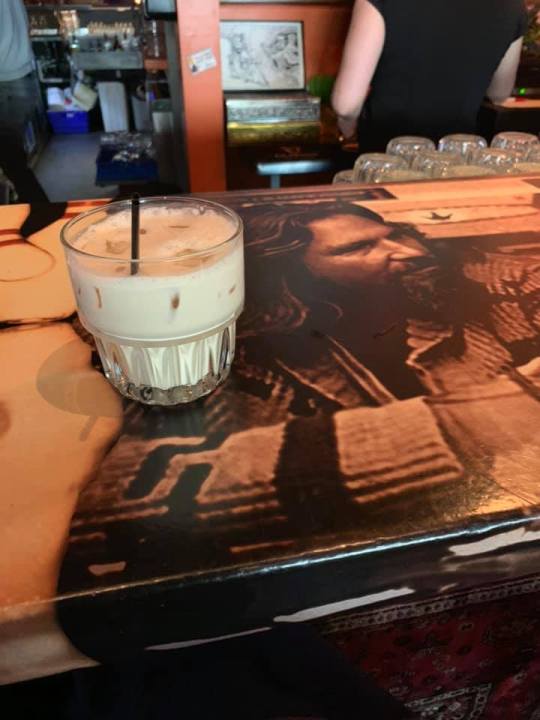
About 3000 ISK later, I took a short walk to the Icelandic Punk Museum to sober up a bit, but it was nothing special. The coolest thing there was a little joke at Hitler’s expense, which is never a bad thing. After the Punk Museum it was time to head on up to Akranes. There was no one at the desk, but my key was waiting for me inside, with the sun still shining at around 10pm. I took a walk down to the lighthouse at the end of town to catch the closest thing Iceland has to a summer sunset, and caught the midnight sun as I got back to the guesthouse for the night. A solid day one.
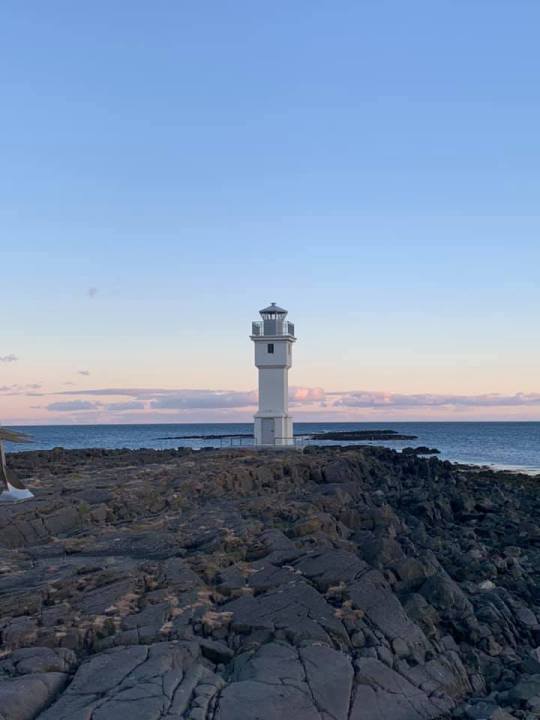
Day 2
Got a late start after sleeping off the jetlag and went right for what I really came for: Hákarl. I knew that fermented shark was pretty gnarly, but I wasn’t gonna miss it. The spot to go find shark is on the Snæfellsnes Peninsula at the Bjarnarhöfn Shark Museum. The museum is located pretty well out in the middle of nowhere, about two hours up the road from Akranes. I didn’t get on the road until almost noon, so I thought I was out of time. I quickly grabbed a cup of coffee and a full tank of gas (around 250ISK per litre!) found my way. I found out later I had quite a bit of sunlight to work with. The Shark Museum itself is a small house on a windswept headland on the northern side of the peninsula. A spectacular view. Undaunted, I paid my 1000 ISK to see the place. The museum itself is a rather eclectic collection of maritime memorabilia and Icelandic antiques. The collection seemed almost unorganized, but I wasn’t there for the collection, I was there for the shark. The presentation was short, but interesting: a burly Icelander explains how the shark is poisonous when eaten fresh because it doesn’t process urine, so they have to basically let the thing rot in wooden tubs before letting it dry out back for a while, leading to its notorious smell. The smell can best be described as a mix of ammonia and urine, which makes sense, and though it is indeed quite foul it’s not nearly as strong or permeating as I expected it to be. It tasted much better than it smelled: like a slightly buttery fish, nothing too offensive. After a short peek at the collection, the burly Icelander directs you to the drying house out back. That’s where the magic happens, and the food gets its stinky reputation. Where the fish was pretty mild, the drying house is extremely pungent and stings your nose. The visual appearance of the shark as its cured is no more appealing: brown, crusty, and oozing with liquid. Overall though, the shark wasn’t too bad. A man in need could almost make a meal out of the stuff, and definitely could make a side dish.
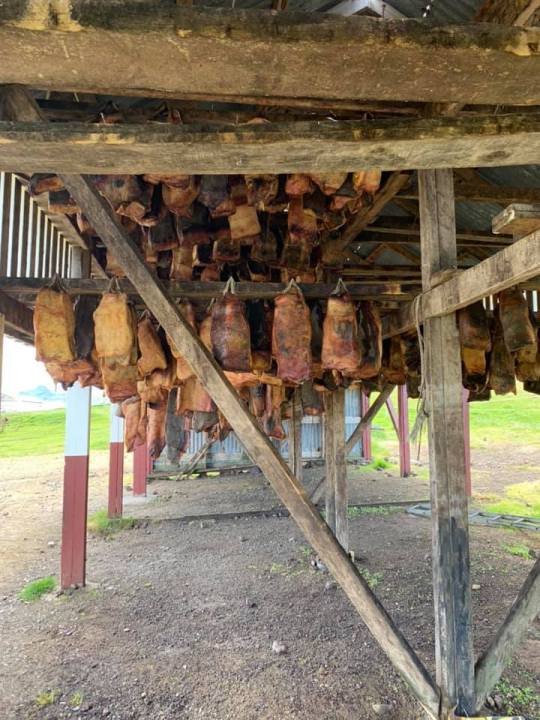
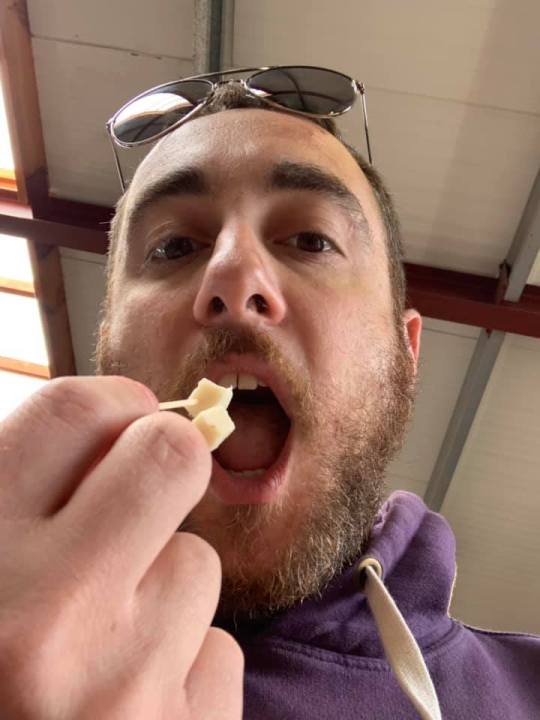
Next stop was Kirkjufell and the town of Grundarfjörður about 30 minutes further out along the peninsula. Kirkjufell was featured on seasons six and seven of Game of Thrones, which was totally why I wanted to see it and not because it was a symbol of Iceland. But that was a nice perk too. I grabbed a hot dog in Grundarfjörður and found a nice little cafe that was also a small library, a great find along the trail. The mountain itself is impressive, and the nearby stream is fed by a sprawling waterfall across the highway. Very picturesque.

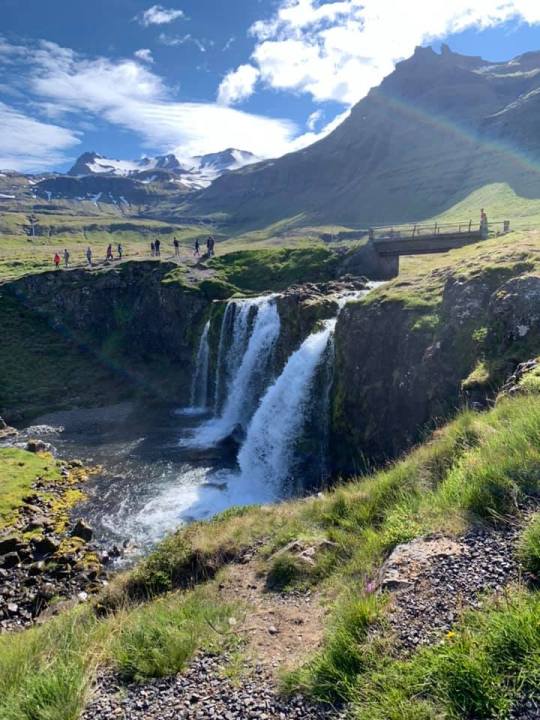

My third and final stop was the Vatnshellir Cave on the far end of the peninsula, about another hour out. I pull in at around 17:50, about ten minutes before they close for the day, and this place is remote. I mean even the WiFi router I brought in the car with me, the one that worked for my entire Iceland trip, couldn’t find anything out there. If there was an “end of the Earth”, this was it. The cave itself is an experience onto itself. They fit you with a helmet and a flashlight, and a friendly guide takes you down a long spiral metal staircase made slick by constant water dripping through the soil. The cave was created by a volcanic explosion, like pretty much everything else on this island, and is layered with eons of nature’s bidding. Afteer some time exploring the worn lava rock, you go down another staircase: this one even longer (about 40 meters) and slicker. At the end of the cave tour, the guide has us all close our eyes and turn out our lights. When we open them, all language barriers between the tour group disappears with a loud “whoa!” in relative unison as we all process the complete lack of light. Pitch black has new meaning there. The darkness is absolute, whole, enveloping. There really isn’t a way to describe just how dark it is with absolutely no sunlight whatsoever. After a few meditative minutes we all climbed back up, glad we had made the trek down. On the way out, I happened upon what looked like the keeper of the lighthouse at the end of the jetty lowering the Icelandic flag for the night. Felt like the perfect symbol to cap off a truly Icelandic day.
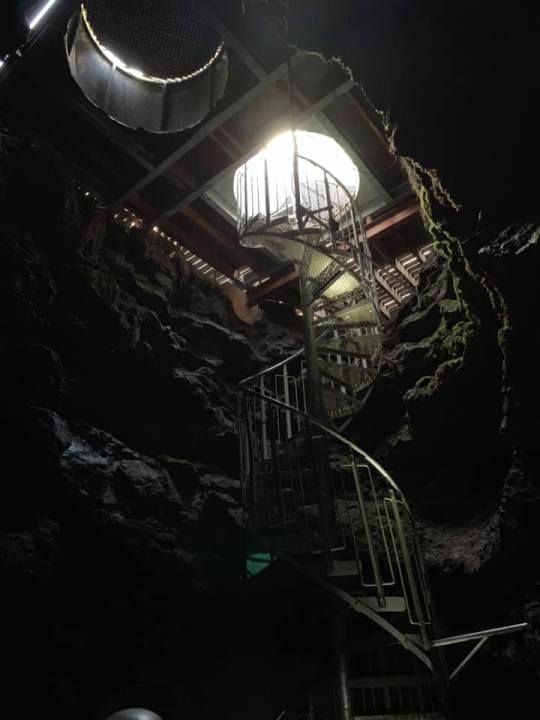
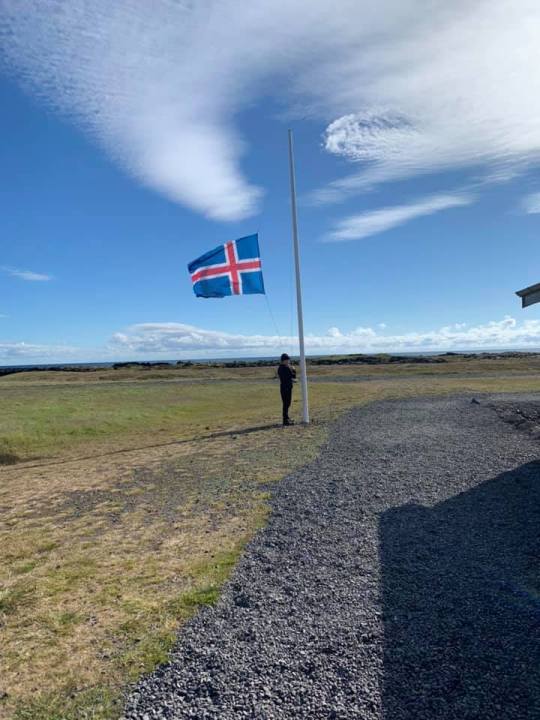
Day 3
My final day in Iceland I wanted to pack in anything else I missed before I took off to Amsterdam. I got up and headed straight back too Reykjavik. The Alþingi building is beautiful from the outside, and claims to be the oldest active parliament in the world, however, they had no tours for the day. Undaunted, I stumbled to the Settlement Exhibition up the street, colloquially called 871+- 2, in reference to the probably year Iceland was first settled by Vikings, within a range of a year or two. The Settlement Museum is very interactive, and contains replica models of some of the houses the original settlers built. The Settlement Exhibition is part of a museum network with two others, of which I only went to one: the oldest extant house in Reykjavik. The house held a small photo exhibition of Icelandic life in 1918, and was fairly well curated.
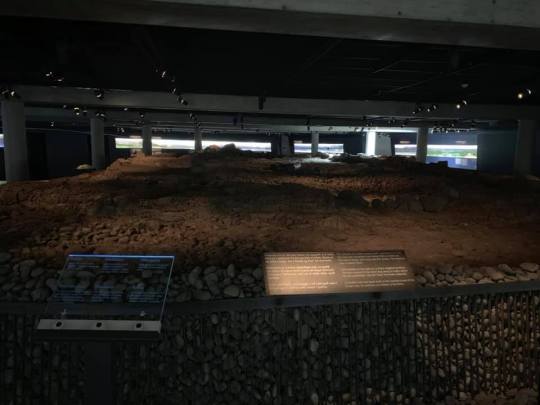

My second stop of the day was...shall we say a little different: the Icelandic Phallocalogical Museum. This guy, for some reason, had a large curated collection of animal penises, and somehow found it within himself to mount and display them in a complete museum dedicated to his collection. There are large penises, like that of a blue whale, and small penises, like that of a hamster. He even has a couple of bronze casts of human penises. The voice on the audio guide never explains why he has such a collection, and why he decided to display it on the wall for everyone to see, but boy does he go into detail about each penis. Far more than I wanted to know, but still worth a chuckle.
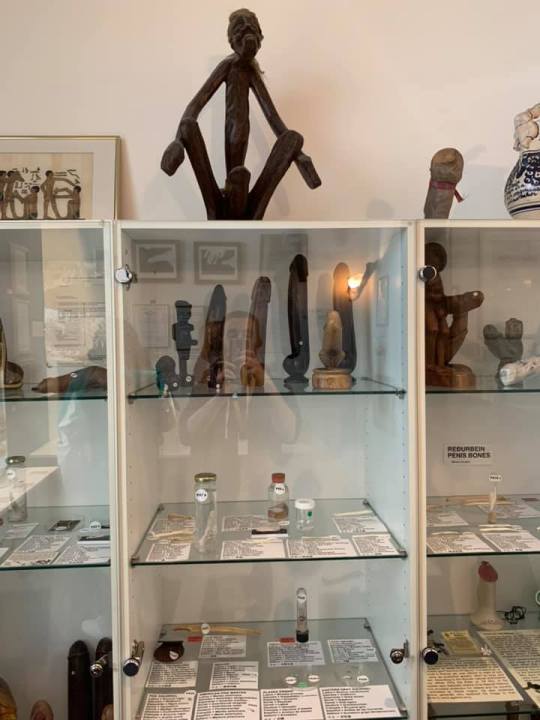

The Icelandic Rock and Roll Museum was only 30 more minutes down the road in Reykjanesbær , and contained a well curated mix of materials dating back to the early days and some bands I had never heard of. I mostly just went to geek on bunch of Björk and Sigur Rós and Of Monsters and Men. The collection did not disappoint. The museum was interactive, and even had a karaoke booth (that wasn’t soundproof, as I found out later). I was able to get my fill of guitars and strange costumes and even a band made out of wood. Fans of MoPop in Seattle (formerly known as the Experience Music Project) might be a little underwhelmed, but this was a fun tribute to the fascinating music history of such a tiny place. I may have spent a little too much time and energy in the karaoke room singing some of my favorites; the woman working at the desk barged in about halfway through song six (I think?) to tell me the room wasn’t soundproof. Oops.
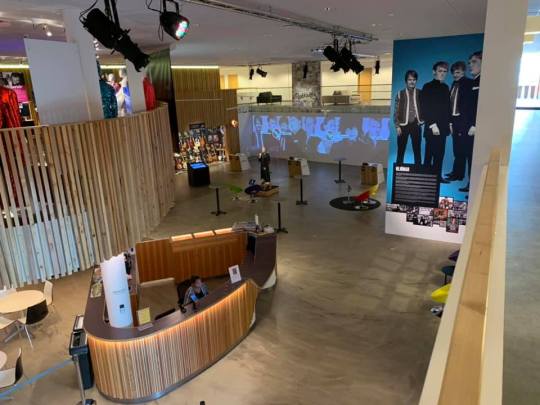
My next two stops were a bit far away, and it was already 3pm, so I needed to hit the road. Only about nine more hours of sunlight. Reykjadalur Hot Springs got some rave reviews on YouTube, and was only about 90 minutes up the road. Or so I thought. The parking lot sits down at the bottom of a steep mountain pass near the town of Hveragerði. A little coffee shop greets visitors, but it had shut down for the day. It was pretty chili outside so I grabbed my sweatshirt for what I thought was a short walk to the river. Turns out the springs itself is a three kilometer walk up the hill. And people swim in the river. I immediately regretted forgetting both my hiking shoes and my swimsuit. The hike up to the springs is stunning. Sweeping valleys and steep canyons give way to open fields full of sheep. So many sheep. They graze in the valley, drink some of the colder water downstream, and even walk right up towards the trail for the freshest grass. Off in the distance steam literally billows out of the earth. The only time I’ve ever seen anything like it was at Yellowstone, but this was different. It was....quiet. Peaceful. The smell of sulfur carries with the wind. Near the end of the hike, you walk right through one of those steam vents, which was somehow simultaneously refreshing and blinding. The hot springs themselves are more like a spot in the river. Something in the soil is volcanic, so the ground heats the water to some naturally balmy temperatures. The bathing area is nearly the opposite of the Blue Lagoon. There are no amenities, there is no one bringing you a drink or offering you a mud mask. There are no saunas or steam baths, or any real facilities of any kind for that matter. Not a roof in sight, not even a restroom. Only a few privacy barriers indicated a potential spot to change out. I wasn’t exactly prepared for a full swim, so I took my shoes off and soaked my aching feet a while. The hot mineral water was quite soothing, really softened up the calluses.
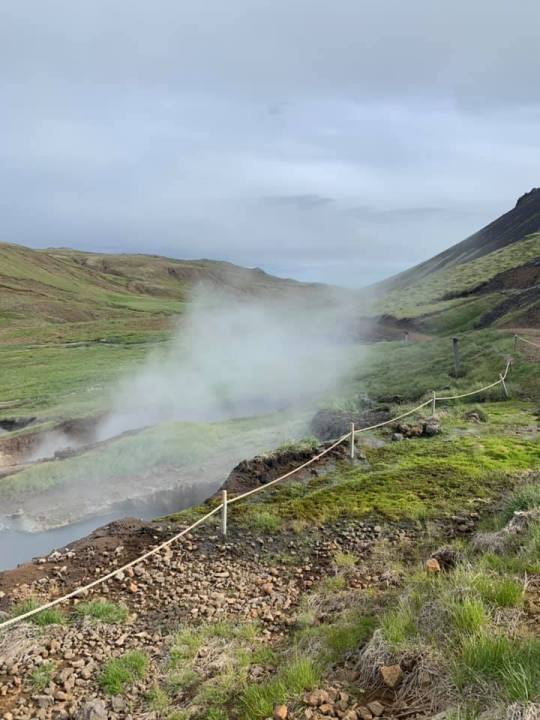
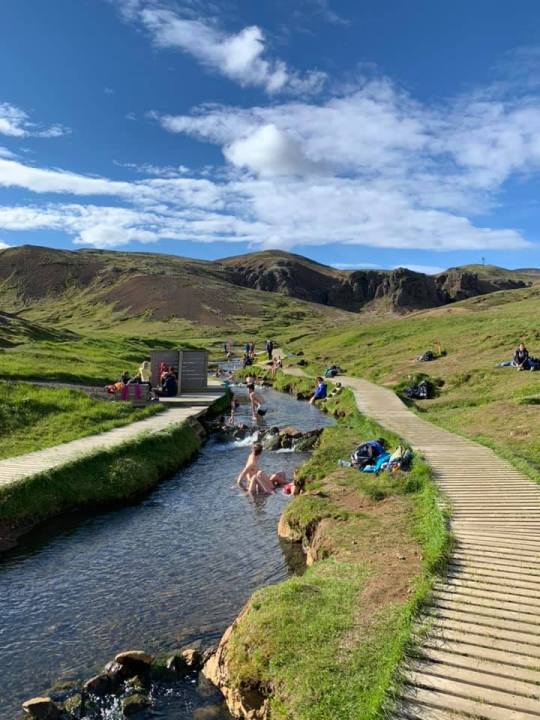
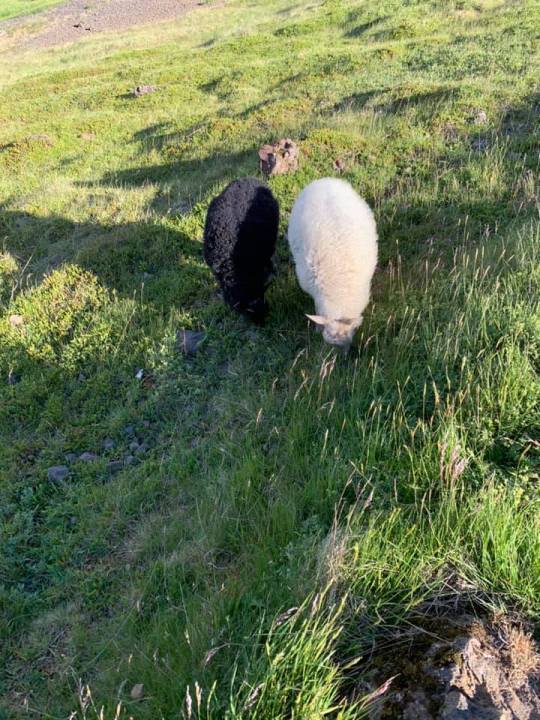
The hike up and down created quite an appetite. I saw a sign on the road back to the main highway for a pizza bar and geothermal brewery: Ölverk. Good enough for me. The place was a little fancier than I expected, but the food and service were both really delicious. Got a pizza with dates, bacon, and blue cheese on it, and it’s probably the only pizza with fruit I’d do again. I passed on the beer: around 2700 ISK for a taster flight of four, 4000 ISK for a draft pour. Makes the ballpark seem cheap. Turns out the geothermal thing was just how they generated their power anyway, which is kinda cool I suppose, but that’s how they generate much of their electricity there. That’s like saying a brewery in Seattle is hydroelectric powered. It was getting late in the day at this point, but my friend recommended I hit a spot a little further up the road: Kerið Crater. It’s a sinkhole, but an impressive one. The parking lot backs right up to the crater, and there’s a short hike around and a staircase to the bottom. At the bottom is a pool of clean, cool groundwater. Like everywhere else in that country, it was created by volcanic activity. Some kind of sinkhole type process. I took the staircase to the bottom, took a drink of the water (tasted great!), and had a lovely conversation with some folks from Russia. A chat with some folks from the other side of the world seemed like a good way to transition to the next portion of my trip. I took a windy route back through the southern portion of Þingvellir National Park, but it was around 10:30pm at that point so I knew I needed to drive the couple hours back to Akranes to make my flight. The back roads were wide open and peaceful: for kilometers on end I might have been the only person. There was also some gravel, but some experience living in the Colorado mountains served me well. I cranked up the tunes and thought wistfully of the summer ahead of me. Amsterdam, I’m ready.
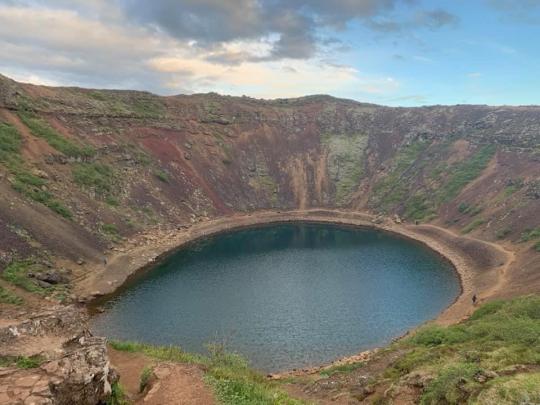
Final Thoughts
Iceland is a place unto itself. My only regret is that I didn’t allow myself one more day. More than that though, oof. It gets expensive. Outside of Reykjavik is extremely rural and provincial, and Reykjavik is indeed lovely, but not exactly the most cosmopolitan or bustling city. I would go back, and would recommend it to almost everyone, but unless you plan on doing some hardcore expeditions you can see pretty much everything in three to four days. For me, it served its purpose: I relaxed at the Blue Lagoon, ate Hákarl, slept off the jetlag, and adjusted to some of the differences of European culture. Overall, a lovely experience. Oh, and be aware the tap water smells like sulfur.
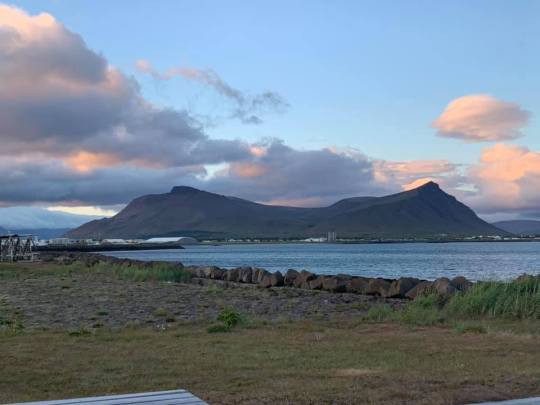
1 note
·
View note
Text
the ecliptic (4/11) - vendemiarie
vendemiaire | 4161 words
elsword | EE, AP, RS, DC
priest!AU: the church of god brings revelations and plagues. a forgotten face returns.
notes plot heavy chapter uve been warned.
There was a cold passing through camp, and no one really knew how it began.
The nights weren't cold, and there wasn't much of a temperature difference from morning to evening. There was never so much as a cool breeze around. Rather, like the forest around them, even the air felt stale and dead. Getting sick seemed almost impossible.
One person started sneezing, and then another, and from there, the cough kept spreading. Within the week, much of the camp had caught it. when asked for treatment, everyone had denied it while sniffling. Everyone that had caught it all said, "We'll be fine in a few days. No need to worry yourself, father."
Erbluhen worried, but despite the illness, the plan continued. Half the camp went forth into the woods to find what lay beyond the outsider's house as planned, and the other half stayed behind to watch the camp.
"I haven't been beyond my house very much, watch yourselves," Apostasia warned. The crunch of the branches beneath their feet was loud and dry, and when they crunched, the branches sounded too heavy and dense to be simply wood. Someone in the camp leaned over them to look and found themselves eating dirt.
Apostasia was swift. within a split second, he had yanked the fool to his feet. The root of the branch that had pulled the victim to the ground shrunk back into the floor in an instant. "Don't touch anything," Apostasia warned again, and grimly, everyone agreed.
The part of the sky they saw through the canopy of blackened branches was overcast. Even though it was day above them, the darkness around them made it seem like night. Even Apostasia, Erbluhen noted, seemed apprehensive. People were intermittently looking at the ground, trying to avoid what had happened earlier, but otherwise, no one spoke, and Erbluhen could almost hear people breathing.
They were not alone. Shadows ebbed in and out of the woods, and the trees seemed to sway though no one felt the wind. The outlines of unknown beasts prowled along the edges of the forest, kept away by the fire in their torches.
Eventually, the branches underfoot thinned out.
They were in a small clearing. Apostasia dropped his pack, and the rest followed suit. A small rest station was set up where they ate supper. Erbluhen was given his own corner to pray to the goddess within sight of the rest of the party, and everyone took their breaks as needed.
The sun had set, though with how dark it was around them, it was hard to tell.
Apostasia was looking up, and when he returned to earth, Chase and Rune had flanked him again on either side. Chase was breaking off a piece of hard bread, and Rune was poking at the fire in front of him with a black branch.
"Did Erbluhen tell you what we were looking for in particular?" Rune asked.
Apostasia shook his head.
"I'm sure we'll know when we see it. Do you know how long this forest stretches for?" Chase asked as well.
"There is no end-"
"What!" Rune jolted, dropping the stick in the fire, "Oh crap, oh crap- anyway, what the hell? How are we supposed to find out what we're looking for if the forest never ends and you don't know what you're looking for?"
Apostasia fell silent and then shook his head again.
When he spoke, a weird echo crept into his voice and his eyes had an almost eerie green glow. "What he's looking for is definitely here." For a moment, the shadows by the light of the fire crept forwards, drowning the campsite in almost complete darkness before receding. Chase and Rune froze, but when the glow simmered out of view, they finally sighed of relief.
"Sit down, Rune," Chase quickly changed the topic, "And have some bread. I brought the jam too."
Rune rubbed his arms nervously and shivered, "...Right, thanks. You can't eat this block of wood without the jam. You want some, 'Sia?"
Apostasia shook his head and stood up, "Erbluhen should be about done now."
"Uh, right." Rune nodded, "See you later."
When he looked down after Apostasia left, the stick he was using to poke at the fire was sitting outside the pile of firewood.
Eventually, they came across an abandoned church, overgrown with ivy. All the tangling branches from the dark forest seemed to retreat from an invisible barrier. The trees pulled themselves back, and they could see the sun again after who knew how many days in that forest.
The party gasped, but most of all Erbluhen seemed to recognize this place. Light shined in his eyes in a way that hadn't before. "This is the church," He gasped softly, "The church Ishmael was looking for." Then he turned to face the rest of the party with a bright smile, "I can hear her. Let's go inside."
"We'll stay here and look around," Chase volunteered, "Just in case."
"I kinda wanna look inside, Chase-" Rune whined.
"You'll be abandoning your duties."
"There's no telling if there might be monsters inside?"
"That may be true, but-"
"But nothing. I'm going inside with them. You take a bunch of people and secure the place, and my group and I will secure it from inside. It's decided!"
With a defeated sigh, Chase acquiesced, "Do what you want, but be safe, alright, and don't get in the Father's way."
"I won't, I won't! Let's go in, then? Number yourselves off or Rock Paper Scissors or something. Be quick about it and let's go go go!" Rune clapped his hands and disappeared among the crowd of knights, but his words were enough to get people shuffling into action. The knight leader took on the role of corralling everyone who was still milling around. Eventually, everything sorted itself out.
Erbluhen watched all of this with a laugh. The echoing "Rock, Paper, Scissors!" over and over was juxtaposing against the sereneness of the church, and even more so against the darkness, they had left behind. Rune was still impatiently running about, trying to get as many people sorted out as quickly as he could. Erbluhen couldn't help but smile. No matter how annoying Rune was, he was helping.
Apostasia's lips parted as he stared at Erbluhen in the sun, but no words would come out, and he didn't know what to say anyway.
"Anyway, we're all done, so let's go, let's go!"
It was probably for the better, so Apostasia gave up and followed everyone into the church. The dull buzz inside his head made it ache, and parts of his body were spasming and twitching involuntarily, but Erbluhen had such a hopeful look on his face that Apostasia bit his lip and pushed on despite the discomfort.
The citadel was oddly well preserved for something abandoned. There was no sign of life, and not even birds nor small animals had settled outside. The only thing that greeted them were dust-covered statues that lined the halls. Even though no one had lived there, and a thick layer of dust coated everything, it didn't seem any worse for wear. As Erbluhen glanced around, it was the same layout as the church in the capital. There was no courtyard here though, only a bell tower with an oversized bell.
Apostasia saw Erbluhen throw him a curious look when he saw the bell tower, and Apostasia shook his head, "I've never heard it."
Erbluhen returned to exploring, but the bell tower and the church were nonetheless still at the back of his mind. Had there been a civilization out here before the corruption? Why would there have a church out here?
They passed through a small antechamber and entered the main hall of the citadel. The sun shining through the stained glass showed off all the high ceilings, but once again, aside from dust, there was nothing there. Erbluhen bit his lip, aside from the beasts that had adapted to the shadows, had all life really ceased due to the corruption?
In the center of the main church, there was a statue of a goddess. Even an idiot could guess who it was supposed to be. As Erbluhen's eyes fell upon the statue, he gasped, "Ishmael," as if receiving a revelation. He fell to his knees, and the party behind him did the same. They clasped their hands together and uttered a silent prayer. Apostasia felt sick to his stomach.
Even though he did not pray, Erbluhen did not look at him oddly or pay much attention to him at all. Instead, he was so focused in his own prayer that the world outside looked as if it had stopped. Apostasia thought about the silence instead. It was so awkward and thick you could feel it on your skin.
But it did pass, and Erbluhen looked more relieved than earlier, even though all they had done was sit there and pray to a goddess that couldn't do anything. "I'm going to look around a little more, will you come with me?" Erbluhen asked him, and despite the uncomfortable feeling in his chest that made it hard to swallow, Apostasia nodded.
In the back of the church, there was a small door that led to the outside. When they arrived at the door, Erbluhen shooks his head, "I'll go on ahead... It's best if I go alone."
Apostasia tried to protest, but nodded, "Be safe. Call me if you need help."
Erbluhen nodded and pushed the door open.
On the other side, twilight graced him. Had they really been in the church for that long? He had left Apostasia behind, giving himself some time to think about the mission ahead. Though Ishmael did tell him the church was the cause of this foray into the forest, she didn't tell him anything else. Where was he to proceed from here?
With an exhale, he scanned his surroundings. He stood in a garden of sorts? Wildflowers were growing in the cracks of the walls around him and through the stone path at his feet. The realization came to him as he was glancing around, it wasn't a garden, but a graveyard.
Gravestones were spread out in the small area. Some had names, but time had etched them out, and he couldn't make sense of the letters that remained. A different language, perhaps, of a civilization long past.
The grave marker at the center of the garden was pristine and unmarked, almost fresh. However, there was still a faint overlay of grey text on top. It was a name and a familiar string of words, both of which were written in his language.
A bouquet of flowers lay at the ground in front of it. Among the bundle, he recognized white lilies and lavenders. With a wry smile on his lips, Erbluhen stood back up again to glance at the sky once more. The warmth of the setting sun and the light breeze felt peaceful against his skin.
Still, he had to join up with everyone else, and Apostasia was waiting for him beyond the door.
He greeted Apostasia on the other side, and with a smile asked, "Shall we go on together?"
Apostasia nodded, and Erbluhen held his hand. The two of them returned to the rest of the party like that.
They joined up with Chase and the others guarding the outside.
"Did you find what you were looking for, father?" The knight captain asked.
"I did. Let's rest here for tonight, and head back in the morning."
"Oh, did the goddess tell you how to stop the corruption?" Rune chirped in.
"Yes," Erbluhen said, even though Ishmael had told him nothing at all.
The news, spread nonetheless. By nightfall, people were already chatting about the revelation Erbluhen had received. Although they were talking amongst themselves so excitedly, the lump in his chest swelled until he was no longer to breathe easily.
A funeral pyre was burning at the campsite in addition to their usual fire today.
Three of their comrades had died under mysterious circumstances, and when Erbluhen struggled to declare the illness, Apostasia spun a lie about overwork and lack of nutrition that had temporarily sufficed.
It had to have been that cough, Erbluhen thought, staring at the flames. He shouldn't have made them push on like that without waiting for it to pass. Beside him, Rune gripped his hand and squeezed. Beside Rune, Chase squeezed his other hand. The boys hadn't been touched by the cough at all, along with himself and Apostasia. Everyone else had caught it somehow and coughed intermittently through the funeral.
Burning would prevent the spread of disease, but what was the point when they were all sick anyway?
There were only three bodies in the fire, but it didn't change the fact that three people had died, and if he didn't do something about it, more would follow. He thought it was a summer cold, but it was something else, wasn't it? The heavy air hung over the camp even as the funeral ended. Although dinner was made, no one had the appetite to do anything but to push the food around on their plates.
Erbluhen felt the animosity in the air as he walked through camp. It wasn't directed at him, how could it be when he was their savior? It wasn't Rune or Chase, it was normal to be blessed when working for the clergy. The only one among those that had not been afflicted without an excuse was Apostasia. The remainder of the camp looked at Apostasia as if he was the one slowly killing them around camp.
"You should eat," Apostasia pushed dinner forward, but the mush looked even more unappealing than usual today. "You need your strength. For yourself, for everyone around you, for me."
For me. If Arme was here, would he have said the same thing? Apostasia stared into his face, and Erbluhen tiredly stared back. The darkness in his eyes was unfathomable, but the depths made everything seem absolved.
"Eat." Apostasia reminded him, so Erbluhen obliged and shoved something in his mouth and chewed mindlessly. Before he fell asleep that night, he prayed to Ishmael for a cure- for something that would relieve the pain of those wailing in agony.
Was it Ishmael who answered the morning when death fell upon them again? Another funeral pyre was set up, and several more bodies were burned. Unlike the day before, those who could walk had dwindled. Those that could attend the funeral all had heavy bags under their eyes, and Erbluhen alone shouldered the weight of their despair.
Apostasia had disappeared shortly after the funeral, but the aura of hate was specific to one area alone. Erbluhen found him in the woods where the shrine to Ishmael stood, far from the eyes of the main camp. Apostasia alone remained unaffected by neither the disease nor the jealousy that floated through camp. It wasn't a surprise he would be singled out.
Erbluhen hid behind the bushes and watched.
"It's all your fault! We were fine without you! You never should have come here!" One of the knights choked through coughs, "The Father was so excited, and none of us really liked you, but for his sake, we put up with you. I don't know how you tricked the father or those two brats, but we won't be fooled by your schemes, demon."
The edge of a knife glimmered in the darkness, Erbluhen's eyes widened.
"Stop!" Before he knew it, he had blown his cover, but the damage was done. The knife in the knight's hand was already in Apostasia's side. It was over. "No, Apostasia-" Erbluhen gasped, "How could you guys-"
But Apostasia had not budged or flinched. Instead of blood, darkness poured out of the wound, leaking on to the ground. He placed a hand over the wound, and the leaking stopped. With a sigh, Apostasia plucked the knife out and tossed it to the side. In the darkness, his eyes seemed to glow with an inhuman light.
"D-demon! A demon's in our camp-" The knights that ganged up on him were already fleeing, not back to camp, but into the darkness of the woods.
Apostasia finally addressed Erbluhen, who had tumbled out of his hiding spot, "So, you've seen."
"I don't know what I've seen," Erbluhen laughed nervously, "Let's go get warmed up around the fire."
No objection and Apostasia merely followed Erbluhen to the fire again. Apostasia's hand felt strangely empty until he realized Erbluhen had not linked their hands together like he always did. His chest ached, just a little, but just enough to remind him of what he was missing.
Erbluhen did not speak to him the rest of the evening, although he could see Erbluhen going through the gestures of conversation, he gave up and finally went to bed. Meanwhile, Apostasia tended the fire all the way until morning by himself.
The shadows ebbed and flowed with each flicker of the flames.
The camp was silent when he woke. Erbluhen tried to sleep a little bit longer, but his body wouldn't listen, and he finally sat up in bed. Apostasia was not in the tent. "Right, we had a fight," he mumbled, shaking his head, "I should apologize." Though the shrine was drowned in darkness, the fire still lit some of the ways. He still remembered the way the darkness crawled out of Apostasia's side, sprawling all over the floor. The ones that stabbed Apostasia must have still been in the forest somehow? Maybe they found their way back?
He couldn't leave Apostasia alone if they came back, so he quickly got dressed and stepped outside.
Apostasia was still tending the fire. "Hey, 'Sia-" He started, and then paused. What should he have said that wasn't awkward? I'm sorry for running out on you last night? I didn't see what saw? No matter what he was thinking, it all seemed rude, somehow.
"Hey," Apostasia replied in response, "Did you sleep well?"
"Hardly," Erbluhen laughed sheepishly, "Can I sit with you?"
Apostasia shifted over to let Erbluhen join him. The two of them stared into the extinguished fire and neither said a thing until Erbluhen finally spoke, "I'm sorry about last night."
"Don't be. You didn't do anything wrong."
"O-oh, well. Thank you." Erbluhen wore a small smile, "You shouldn't worry about those people. They were just jealous and stressed. People are dying... and... it's pretty hard on all of us, you know?"
"I know. I'm not worried about that. I'm worried about you."
Erbluhen's heart skipped a beat, "Sorry?"
"They aren't important. Only those that are insignificant catch the corruption." Apostasia's tone was cold, and the lack of emotion and surprising harshness made Erbluhen's blood go cold.
"Insignificant?"
"Yes. You and the boys are significant. That's why you are not sick." Apostasia frowned, "But if you spend too much time with me, that may change."
Erbluhen was shaking, "What are you talking about? How can people be divided into significant and insignificant? Everyone is important to someone! Even those people that threatened you must have been important to someone!"
"That's not what I was-" But the damage had been done, Erbluhen was standing up already. His hands were balled up with rage and Apostasia could see him shaking with rage. "Ah... I'm sorry." Apostasia shook his head, "I'm sorry. I said something wrong."
That seemed to calm Erbluhen a little, but just a little. At least he had released his fists, and with a sigh, shook his head as well, directing his gaze to the fire pit. "It's fine. Don't worry about it. I'm just... a little tired. I shouldn't have gotten cross with you."
Apostasia shook his head again, "You didn't do anything wrong."
Erbluhen sat back down and put his head in his hands. He let out another heavy sigh, but it was simply of resignation instead of any relief. When he felt Apostasia try to put a head on his shoulder, he spoke with his eyes still covered, "I'll be fine. It's just a lot of process."
Apostasia withdrew his hand, but his body still felt tense with worry until Erbluhen leaned into him. "It'll be okay, right? I'm doing an okay job, right? Tell me, Apostasia, what should I do if the goddess won't answer me?"
But Apostasia had no answers for him.
How many days had passed since the first pyre? Erbluhen figured it couldn't have been more than a month.
The smell of ash seemed permanently embedded around camp, in his clothes, in his hair. A thick layer of dust had settled on everything, perhaps even his soul. Despite this, and despite the hopeless silence that came with the death of everyone in camp, Erbluhen had not given up. The heavy bags under his eyes could not hide the sliver of hope he continued to hold. Ishmael had not abandoned them. She wouldn't. The instant he saw the grave, he understood.
Sitting at his desk that morning, without eating breakfast, Erbluhen thought about what he could do. Out here, Rune and Chase would not survive. Apostasia would return to his house. In terms of pure survival, there would be no problem if he sent the kids back to the capital. He would apologize to Arme with the paper they still had left.
When he went to the shrine to find a keystone for Rune and Chase, Apostasia was there.
"Sia, good morning!" Erbluhen greeted him as cheerfully as he could.
"Good morning." Apostasia's response was as emotionless as always, "Are you praying?"
"Erm, no, rather-" He explained his plan to Apostasia briefly, who nodded in acceptance or agreement. "But I will before I do that."
"I'll leave you alone then."
"Yeah, see you in a bit."
He made a quick prayer and picked a stone that made up the foundation of the shrine of the church. Although it would collapse the shrine, it would prevent Arme from contacting him once his letter reached its destination.
From here on out, he would be a heretic.
Rune and Chase alone greeted them sometime in the afternoon, and it was heartbreaking to say that Erbluhen had grown used to the solemn expression on their face.
"I need you to do something for me. It's for the mission." Erbluhen handed them the rock from Ishmael's shrine and placed it in Rune's hands, "Take this and the letter back to the capital. Make sure Father Arme gets the letter. He's the only one who'll believe me, you know? I asked for reinforcements. The mission can continue but... we've lost too many people."
Emboldened by Erbluhen's lie, Rune's eyes lit up again. "We-We'll do that. We'll definitely do that. We'll set off tomorrow morning, bright and early, and then we'll come back to you as soon as we can."
Rune was talking too fast, and Chase wasn't even so much as getting a word in. Erbluhen didn't need him to say anything to know that Chase was wearing a similar expression: of relief, of excitement, of hope.
When Erbluhen saw them off the next morning, Apostasia knew.
The boys would not return, even though they had promised to do so. The goddess Ishmael had abandoned this camp. When he made his rounds earlier, he saw the shrine toppled over, collapsed in on itself.
So even though Erbluhen saw them off with smiles, Apostasia did not miss the blood-red mark of Ishmael etched onto the stone.
Just like that, they were gone.
Apostasia found Erbluhen in his tent with his head in his hands and eyes closed in meditation. When he heard Apostasia step in though, he broke out of his trance and gave him a nervous smile, "Did I do okay?"
"You did fine," Apostasia said and reached forward to place a hand on Erbluhen's cheek. The light of candle glimmered against Erbluhen's cheek. Tears had welled in his eyes, even though he had yet to cry.
"It's going to be lonely from here. I thought I was doing something good... I thought... mmm. If you want to go home, I won't keep you."
Apostasia shook his head, "Come live out the rest of your days with me."
"My," Erbluhen laughed, "It almost sounds like you're proposing."
Mass ran over today, and Arme returned to his suite late in the evening against his wishes. It was always good to pray, but combined with the hubbub of the failed expedition, it was just a mess and a half to think about the city in the morning.
Unexpectedly, a rock bearing Ishmael's sigil and a wrinkled letter sat on his desk. He had no taste for the grotesque, the blood on the face of the stone made him wrinkle his nose.
But the letter was no more to his liking than the stone. There was no blood nor nothing grotesque in it, but it sent his usual decorum into a frenzy.
If Erbluhen would not come home, then he would just have to go get him.
『 if just one thing is eliminated, then this world will continue on. 』
#elsword#f: the ecliptic#v: priest!au#rib tries to fic#brumaire (5) is 1/4 done#ambiguous word choice is important
9 notes
·
View notes
Text
Days 168-174: Oberwesel and a Week on the Rhine

After a busy week in Munich, it was time for a scenic and relaxing week on the Rhine. We’d be staying in a charming little medieval town called Oberwesel, halfway between the cities of Frankfurt and Koblenz. None of the Germans we’d talked so far had ever heard of it. Which is a shame because it’s gorgeous–and also dead quiet. But we’ll get to that later.
We didn’t fit in quite as much sightseeing as we’d hoped, but we did get some rest and relaxation that we desperately needed. After nearly six months abroad and with only three weeks left, we were starting to feel the strain of constantly staying on the move.


The train ride from Munich to Oberwesel was long but easy, and toward the end we got to enjoy a lovely preview of the vineyard-laced Rhine river valley.

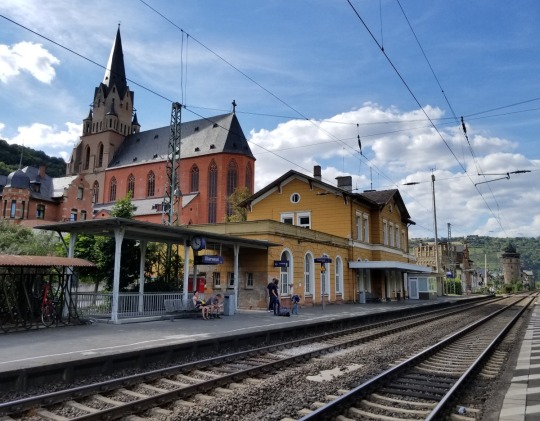
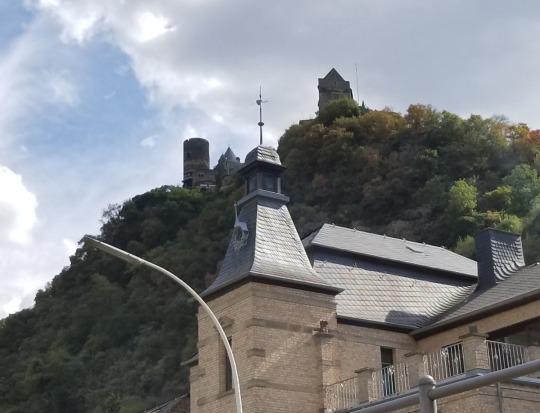
From the train station, we could just barely see the local castle–now a hotel and restaurant–peeking up from the top of a nearby hill.
Our host kindly offered to pick us up at the station and drive us to our Airbnb. It was only about half a mile away, and it might have been faster just to walk rather than wait, but after five and a half months on the road, we were grateful for any opportunity to not lug our packs across town.

Our Airbnb flat was wonderfully spacious and comfortable, with a large dining/living room, a full kitchen, and two full bedrooms. It was one of our best homes through the entire trip, right up there with those in Avignon and Betws-y-Coed.
After settling in, we set about finding something for dinner. It was a Sunday evening, so the grocery store and most of the restaurants were closed. Luckily, we found a delightful little garden restaurant where we enjoyed some great food and a tasty local wine–a perfect introduction to the region.
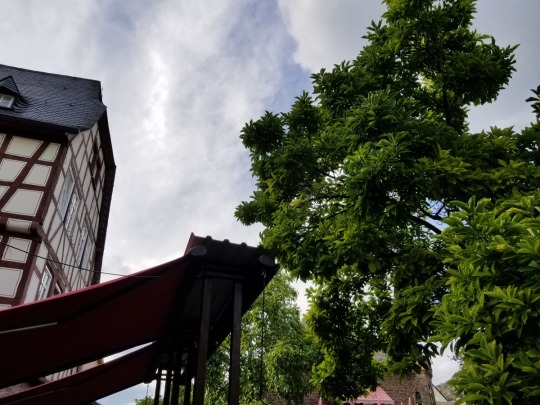
After dinner, there was still plenty of summer sunlight left, so we took a relaxing walk around the town.
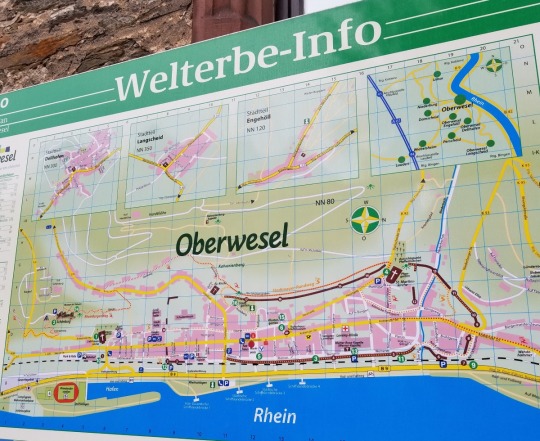
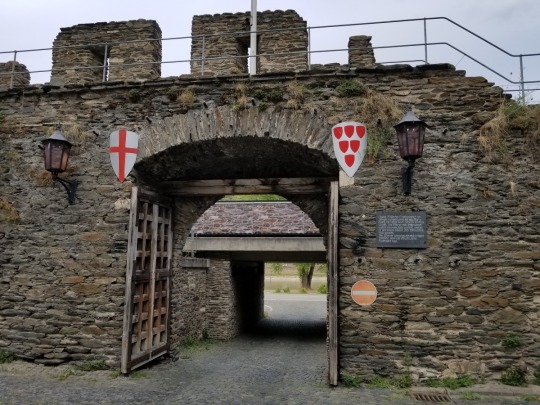
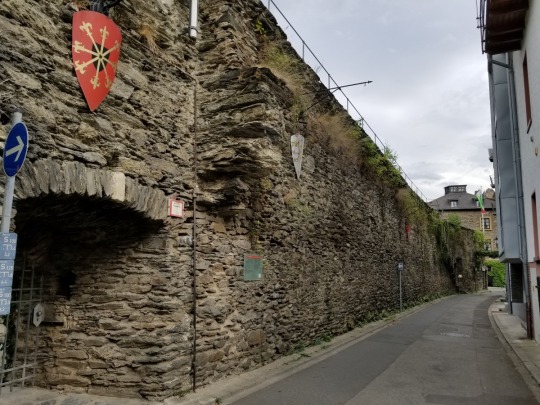
The Rhine is positively peppered with old castles and walled towns, and Oberwesel has the best-preserved medieval walls of them all. Inside these walls is a charming collection of buildings that mostly date back to the 19th and early 20th centuries, but some of the houses and churches date back to the Middle Ages.

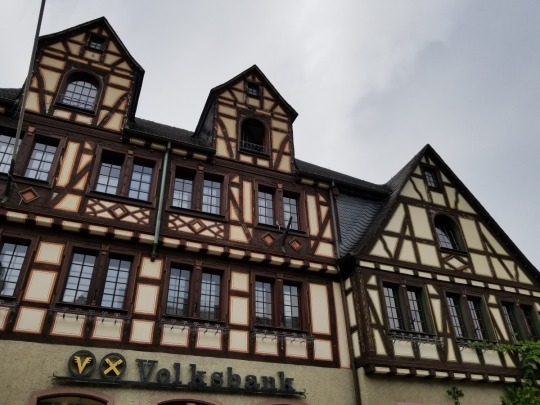
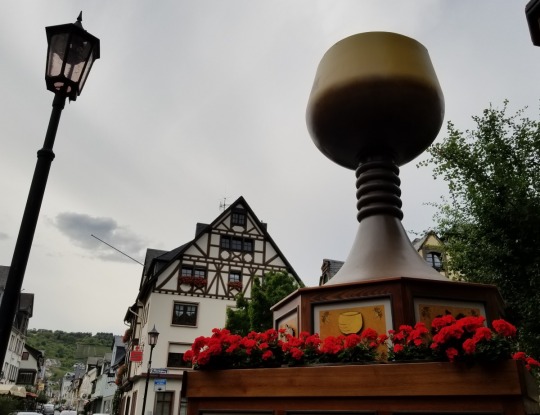
In the center of the town is a small but proudly ornamented market square, featuring the beautiful town hall, the local bank, and a statue of a giant wine glass.
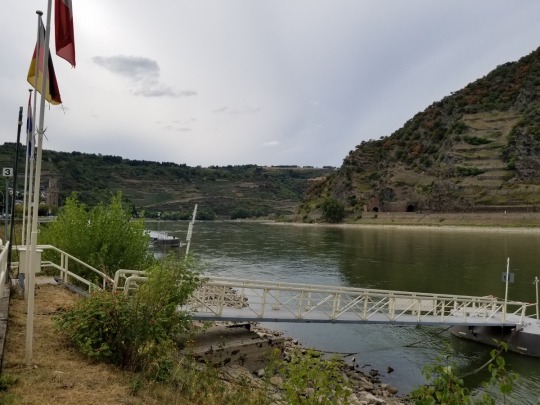
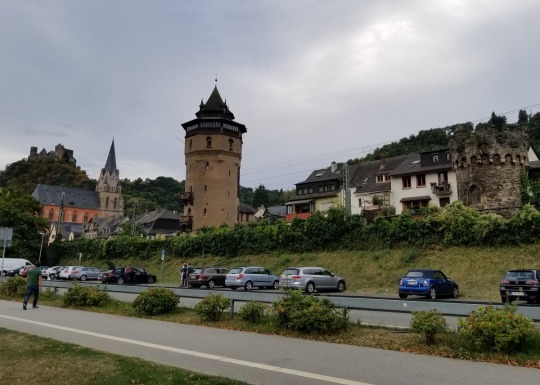

Going out through the walls, Jessica and I walked along the waterfront. We spotted the ferry office where we’d need to book tickets for our Rhine cruise on a later date, and we got some more great views of the town.
—

The next day we visited Frankfurt. It was a fun if somewhat unstructured day trip to a very historic city, and we had a pretty good time. We’ll cover it all in our next post.
—
Our first full day in Oberwesel was a lazy one. We slept in, walked over to the local TI to get some information on the local wineries and wine bars, then went grocery shopping. There are two main grocery stores in Oberwesel, and they're both on the far southern outskirts of town--nearly a mile away from where we were staying. Not having a car, we would have to balance the number of trips we wanted to make with the amount of stuff we wanted to carry each time we went shopping.
After bringing our food haul home and fixing up some lunch--consisting of fresh rolls, knackwurst, and sweet mustard--we went out to wander some more around town.
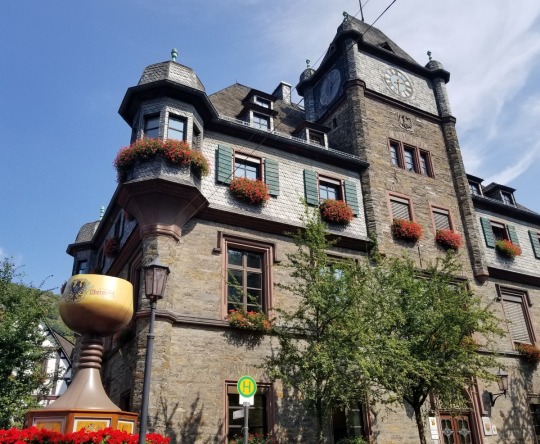
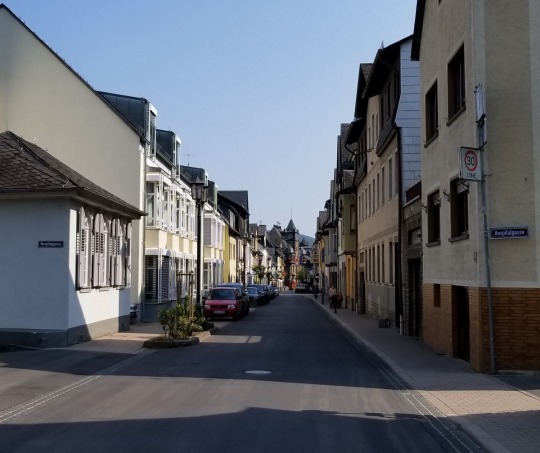
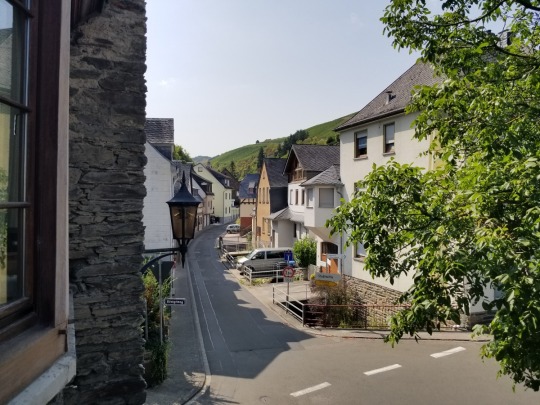
Even in the middle of a weekday, Oberwesel was almost depressingly quiet. It seems like these Rhine villages only really come alive on Fridays, Saturdays, and festival days, when all the wine shops open. Otherwise, a lot of stores seem to stay closed during the week or else keep very short hours. Many storefronts were boarded up, and "For Lease" signs were visible on almost every corner outside the main market square.
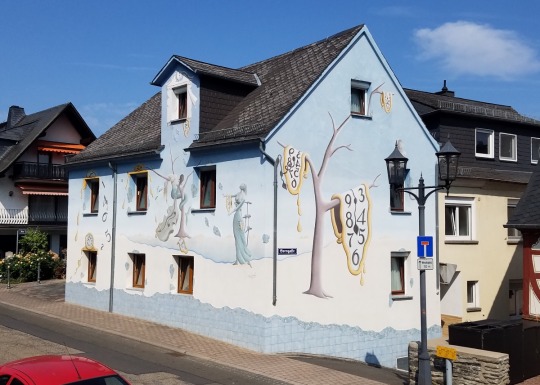
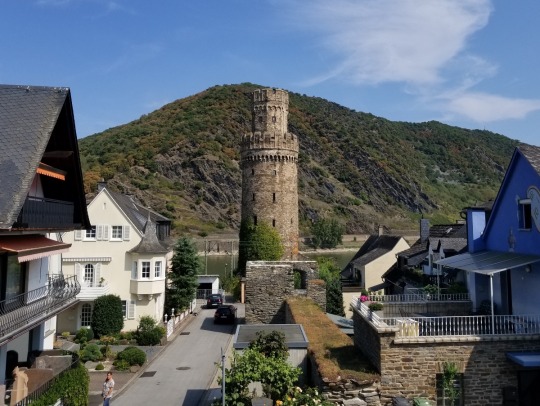
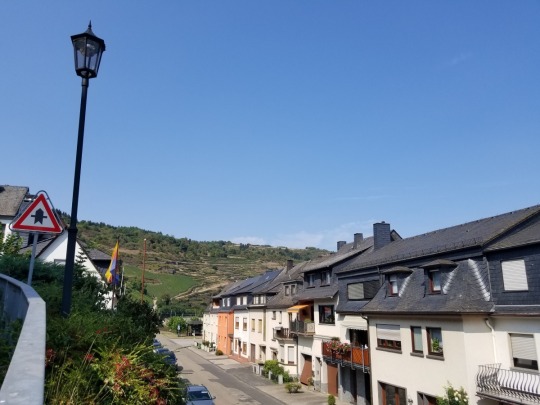
Still, despite the borderline ghost-town atmosphere, it was spectacularly picturesque.

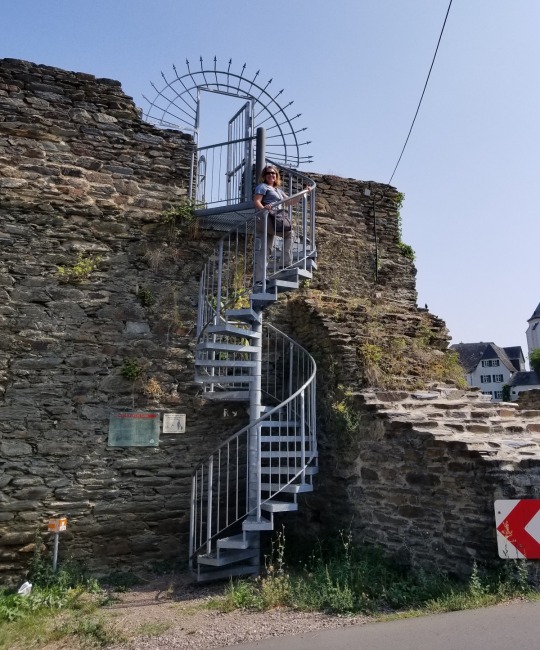
We wandered up toward the northern edge of town and eventually climbed a staircase leading up onto the walls. There was a group of wasps busy at work, but we gave them a wide berth and enjoyed some spectacular views of the town.
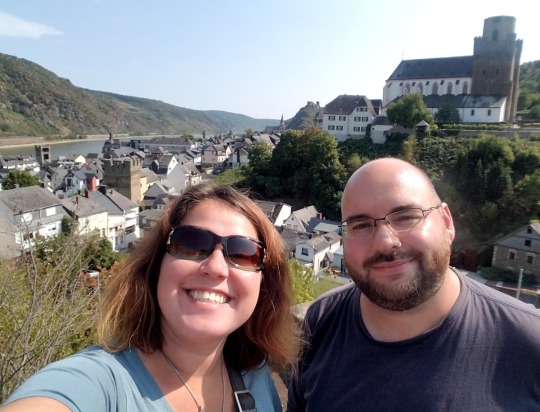
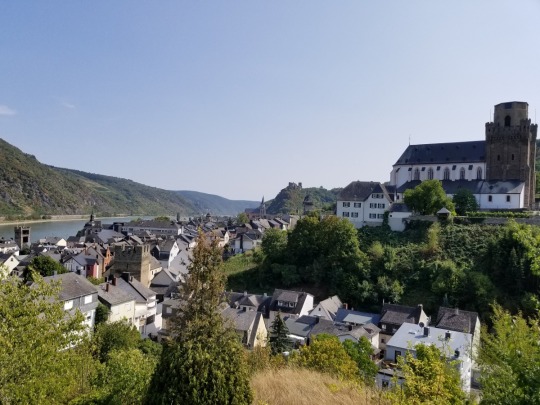
We took another path down from the wall and saw a little outdoor chapel, featuring icons of local patron saints.


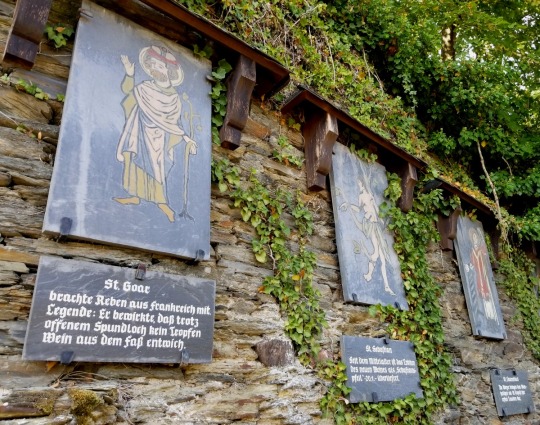
Making our way back along the wall into town, we stumbled upon an old hotel bearing a commemoration plaque. Apparently, this hotel is the site of one of the first known performances of the German national anthem ("Deutschland, Deutschland uber Alles…").

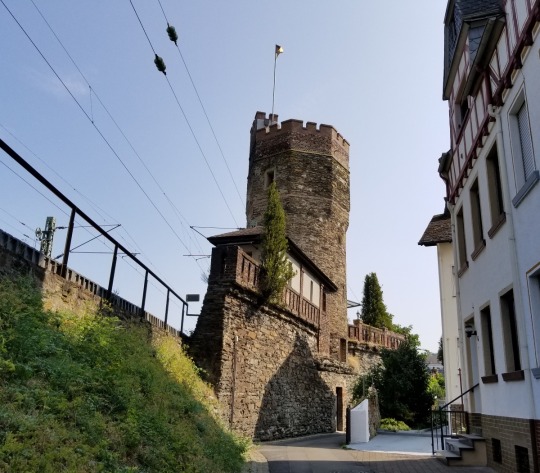
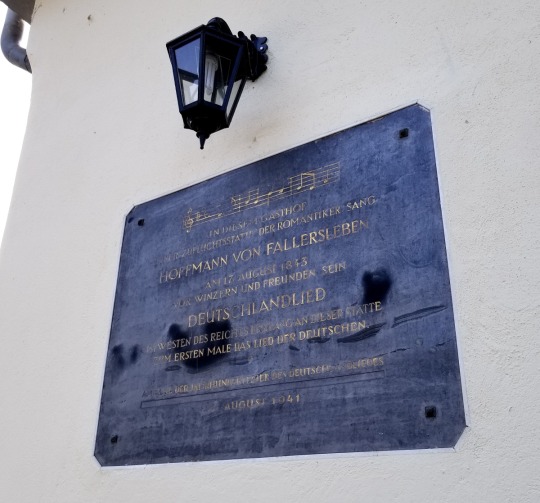
Ironically, while this song's call to put Germany Above All was tainted by the Nazis, it was originally intended as a call for liberalization. At the time it was written in the 1800s, Germany was divided into a confederation of autocratic states that put their rulers' squabbles and ambitions above the welfare of the people. The anthem's call was meant to encourage a united Germany where the good of the people came above political infighting.
On a corner near the market square, we found another testament to the damage done by the Nazi regime--a holocaust memorial dedicated to the town's Jewish residents who were deported or arrested by the Nazi regime.

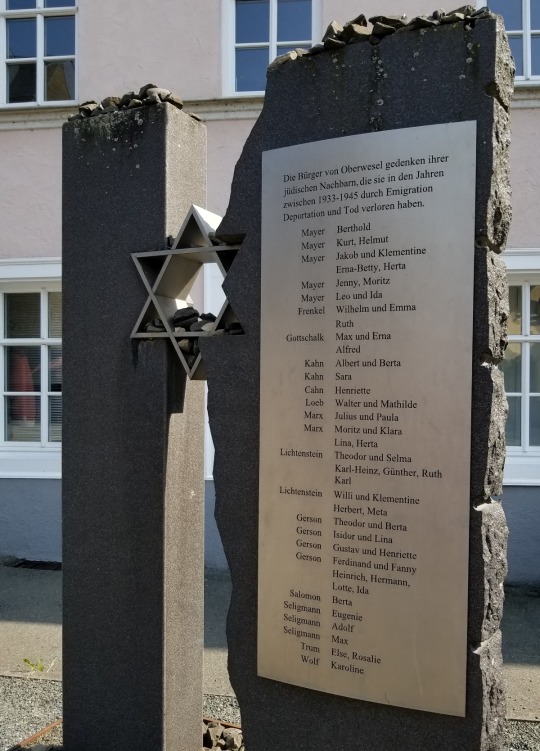
On a happier note, Jessica and I were able to make a purchase that we had long been looking forward too--a pair of Rhine wine glasses.
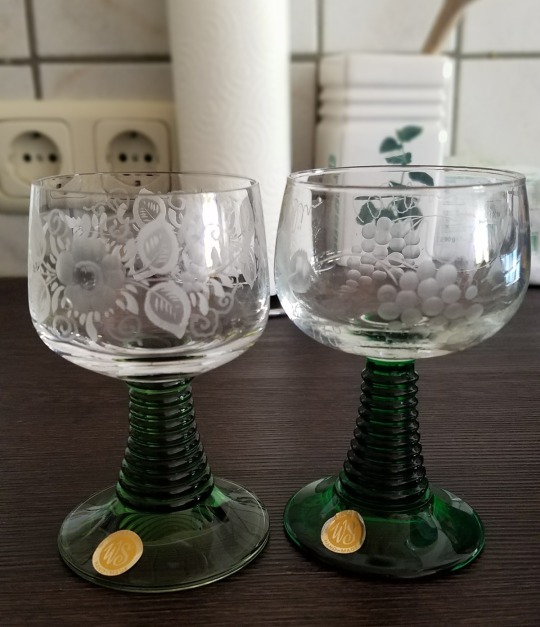
There seemed to be only a single tourist shop in town that was open that day, but they had a great selection of Rhine glasses and other souvenirs.
—
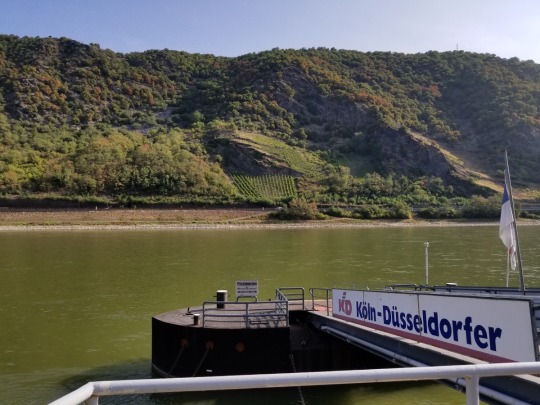
A cruise along the Rhine is an absolute must-do for anyone visiting the area. It proved a bit more complicated that we had anticipated, however, and we probably would have had an even better time if we had a bit more sense what we were getting into.
Ferries go up and down the river all day, but it's a long ride with a tight and complex timetable. Trying to figure out which tickets to buy was also a bit of a head-scratcher. You can get a hop-on-hop-off type ticket, but it's expensive and there aren't enough boats that you can take much advantage.
After puzzling it over between ourselves, Jessica and I eventually just decided to ask the ladies at the KD Rhine ticket counter what we should do. The first thing we should have done was to just go up and ask them in the first place, since they were able to sort us out very quickly.
Our plan was to start in Oberwesel, ride north downriver to Koblenz--a medium-sized city at the confluence of the Rhine and Mosel rivers--stop for lunch, then ride back upstream past Oberwesel to the popular tourist town of Bacharach. After exploring to our hearts' content, we would catch a quick train back home to Oberwesel.
After a couple minutes explaining this to the ticket ladies, they recommended a round-trip ticket from Bacharach to Koblenz as the most economical option.
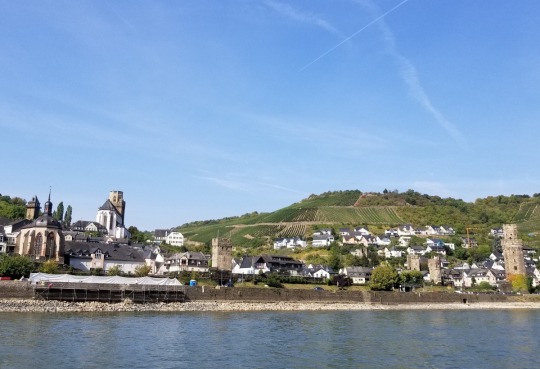
Finally, our boat arrived and it was time to board. We were a little nervous when we first boarded. Far from the luxuriously lazy experience I was expecting, the boat was packed shoulder-to-shoulder with tourists and nowhere to sit down. There was also no wifi onboard, contrary to the cruise company’s advertisements. We had been hoping to get some work done on the return ride, but if the crowds stayed the same, that wouldn’t be an option anyway.

More concerning was the lack of any food service onboard–also contrary to the advertisements.
At one of the next stops, however, a large group disembarked, and there was room for us to sit down, for Jessica to take a Dramamine, and for both of us to just enjoy the ride. A huge chunk of the tourists who got off were Japanese. Apparently, one of the castles is privately owned by a Japanese businessman, and the nearby town of St. Goarshausen has become an object of fascination among Japanese tourists.
It's funny how different places become tourist destinations for different cultures. I'm sure Heidelburg would not have become a mecca for American tourists were it not for the American GI’s stationed there after WWII.

The Japanese castle is called Burg Katz, which means Cat Castle. Close by stands the rival Mouse Castle. And across the river from Burg Katz is the massive Rheinfels Castle in St. Goar, which Burg Katz was built to supplement. Between the two of them, the owners could command an entire stretch of the Rhine.
Because that's what all of these castles were built to do.
As we've learned so thoroughly, Germany spent the vast majority of its history as a constellation of semi-independent states that were allied more in theory than in practice. Local lords had free reign to raise money and fight for their own interests in pretty much any way they saw fit.
The Rhine was one of the busiest trade routes of them all, and everyone wanted a taste. Castles were erected every few miles, and sometimes much closer. Not for war or defense, but for toll collecting. Any trader wishing to raft their goods downstream would need cash for dozens of tolls along the way.
Most of those castles fell into ruin or were destroyed during various border wars with France, but a good handful have survived or been rebuilt by wealthy enthusiasts.
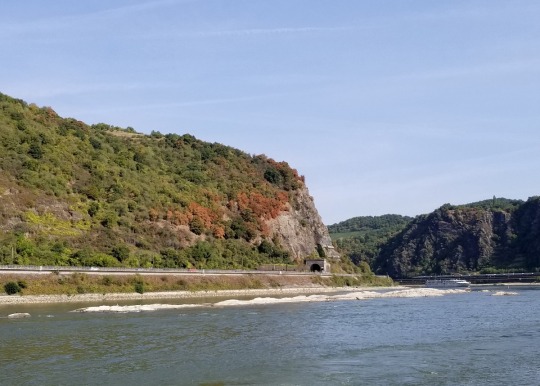
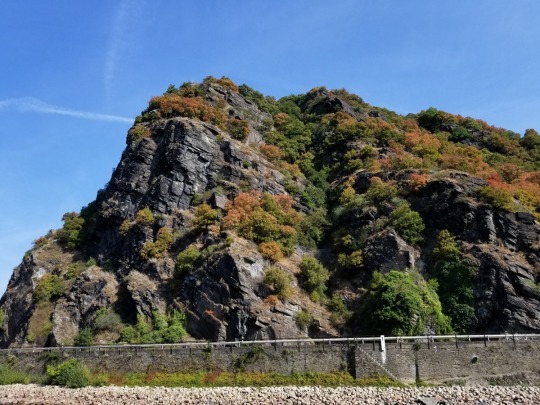
Nature provided its own set of obstacles as well. As idyllic as the sleepy valley seems to us, parts of it were a menace to sailors. Just downriver of Oberwesel lies a cluster of deadly reefs known as the Seven Sisters, followed by a narrow hairpin turn in the shadow of a massive, echoing cliffside known as the Loreley (a sort of Germanic equivalent to the mythological Green sirens). Simply making it the few miles from Oberwesel to St. Goar could be a day-long endeavor and would certainly merit an evening's celebration.
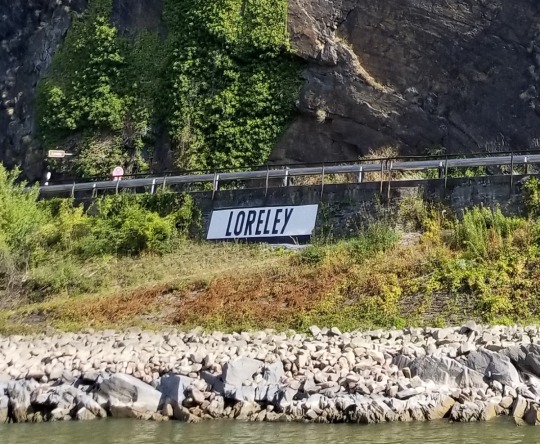

High-contrast signs and kilometer markers posted along the banks of the river make it easy to follow along in a guidebook.

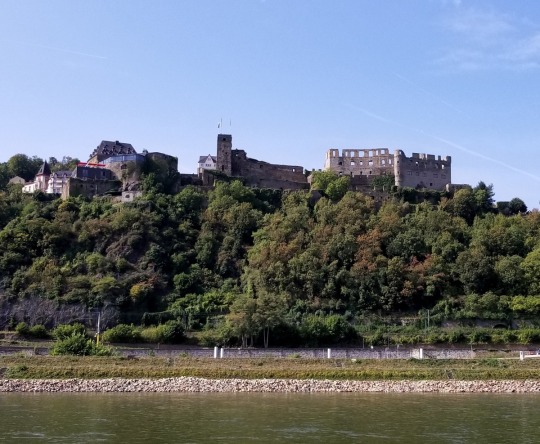
Above St. Goar looms the aforementioned Rheinfels Castle. Now a hollow ruin, it was once one of the mightiest castles in the entire Holy Roman Empire--a bastion of vigilance against the threat of French invasion.
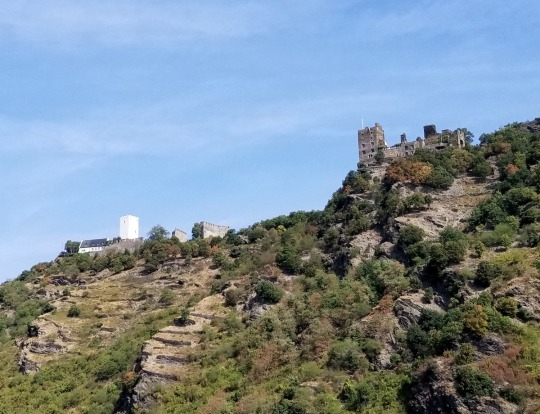
Further downriver stand the twin castles of Sterrenberg and Liebenstein, joined together by a long defensive wall.

Even further downriver are the charming town of Boppard--where we had originally considered staying--and the brilliantly whitewashed Marksburg Castle--possibly the best-looking of all the Rhine castles.
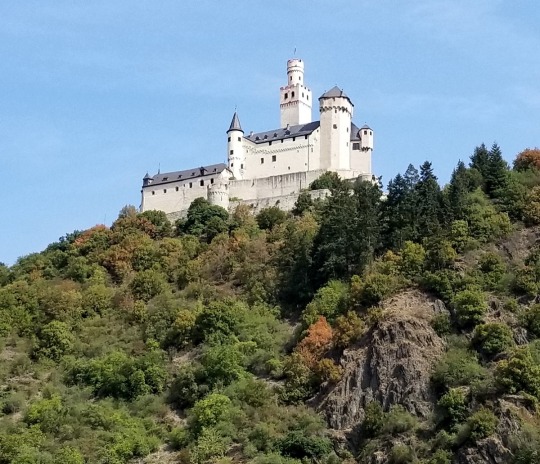
Marksburg was never destroyed, and it has been restored to look more or less like it would have back in the days of the Holy Roman Empire.
Learned from Rick Steves that there are two German words for "castle," each with its own meaning. A burg is a functional castle like pretty much all of the castles on the Rhine once were, whereas a schloss is luxurious castle used primarily as a prestigious residence, like Neuschwanstein and Hohenschwangau back in Bavaria.
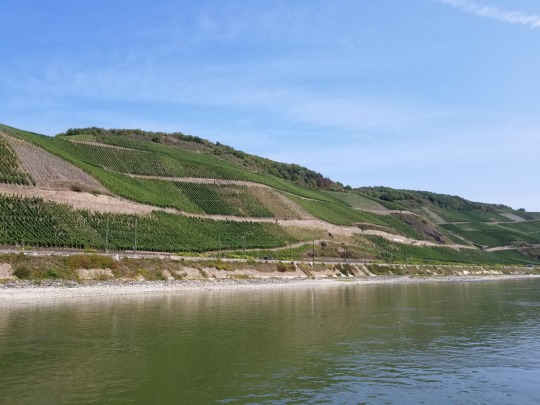
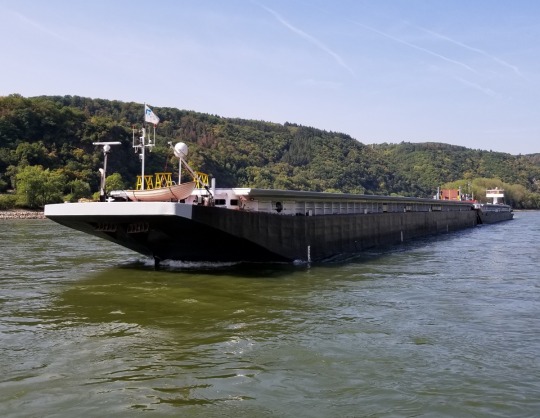
The last stretch of the Rhine is mostly filled with long lonely vineyards and a constant stream of commercial barges going past in both directions. Even in the age of trains, planes, and ultramax cargo ships, the humble river barge remains a mainstay of European trade.
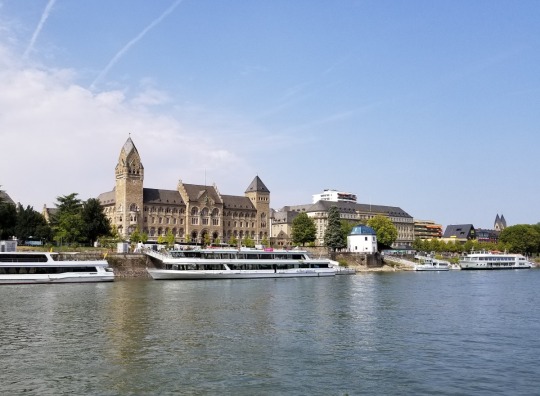
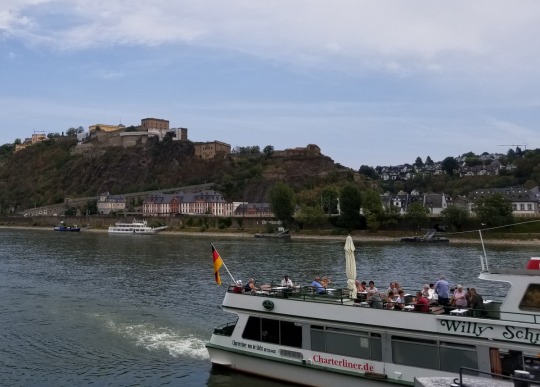
Finally, we arrived in Koblenz. It seems like a nice city, but we were hungry and in a hurry. Since there hadn't been any food on board, getting something to eat was top priority. Moreover, our boat was behind schedule, so we had just 30 minutes to get off the boat, find something to eat, eat it, and get back on the boat with enough time left to get a good seat.
The closest fast food or grocery store we could find on our phones was over 10 minutes’ walk each way, so we ended up just grabbing a bratwurst from a nearby stand, scarfing it down, and getting back onto the boat. Luckily for me, we had brought some meal bars just in case.
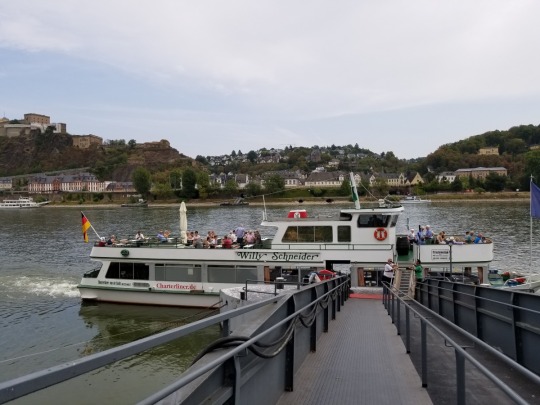
We decided to enjoy the upstream journey below-decks, where we could enjoy some comfortable seats, cold beers, and a table to set up our laptops and get a bit of planning done.
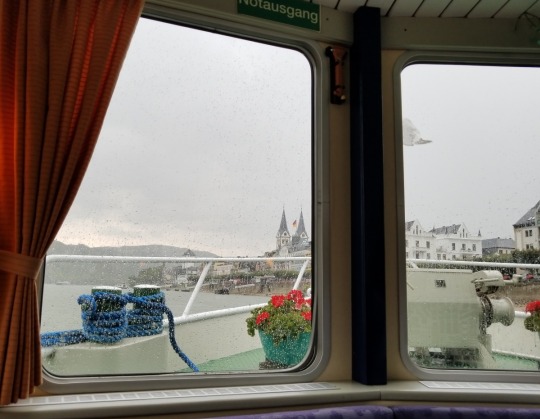
About halfway back, though, it started to rain–driving everyone above-deck down below. Then we picked up a huge crowd of people from one of the towns. Our quiet, comfy booth soon became a crowded, stuffy, and painfully noisy confinement. I must admit that the pressure of all the planning, moving, and sightseeing we'd been doing hit me especially hard that day, and that hour in particular was not my happiest. At least the beer helped once I finally broke down and ordered one, too.
The rain had mostly died down by the time we were nearing Oberwesel, so I went back above-decks to get some views and fresh air.
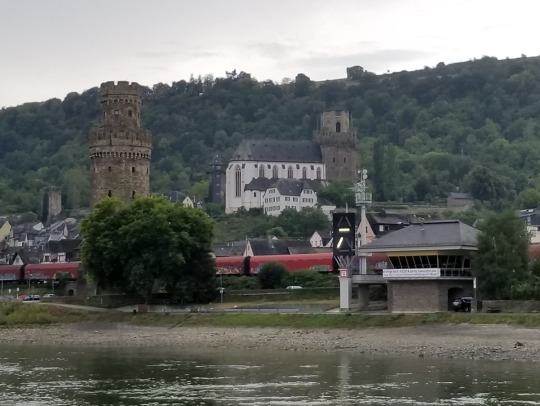

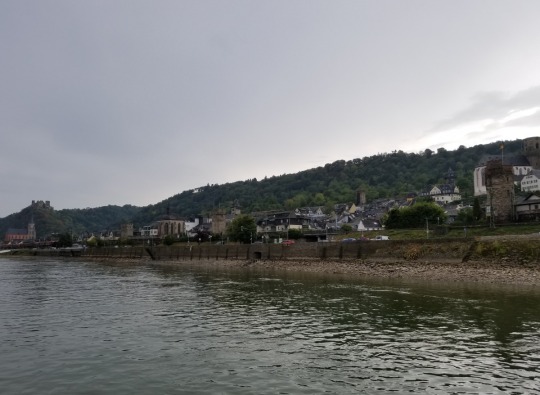
But remember, we weren't done yet. We'd be heading a few stops further upriver.
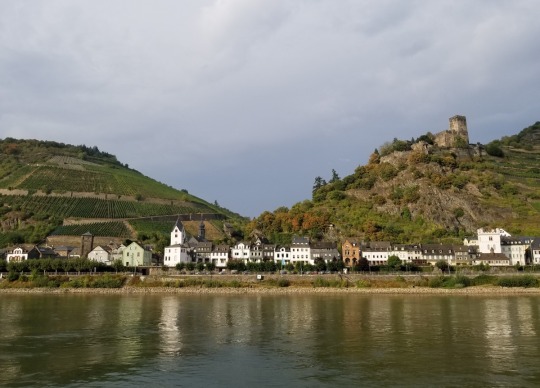
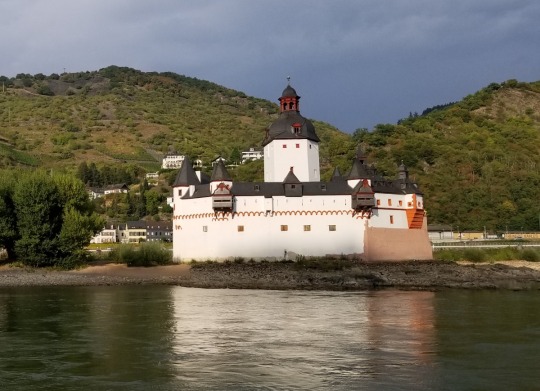
Just upriver from Oberwesel lies the painfully postcard-perfect town of Kaub. On the hillside nearby stands Gutenfels Castle, while its sister Pfalz Castle sits right in the river--the ideal spot for collecting tolls.
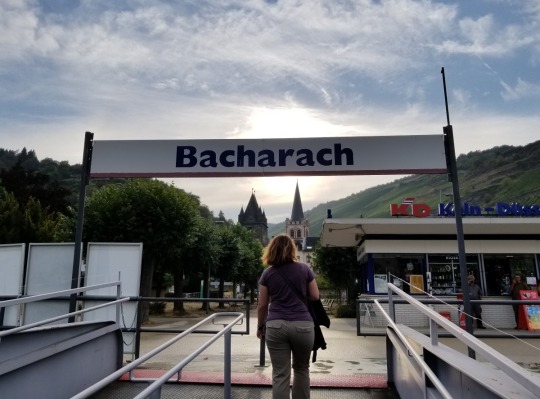

Finally, with the lowering sun piercing the clouds like a spotlight, we arrived at our final stop--Bacharach, a winemaking town named after the god of wine Bacchus himself.
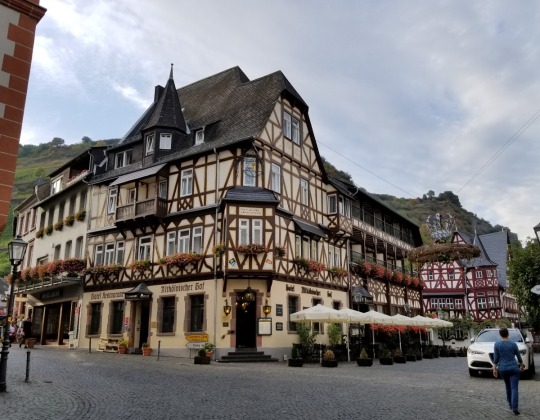

Bacharach is Rick Steves’ top recommended place for staying on the Rhine, and after visiting it we can see why. It’s not as big as Oberwesel or dramatic as St. Goar, but its sweeping hillsides, cobbled streets, and half-timbered houses are a photographer’s delight. Seriously, if we had an extra day I’d be tempted to come back and spend it all just taking pictures.

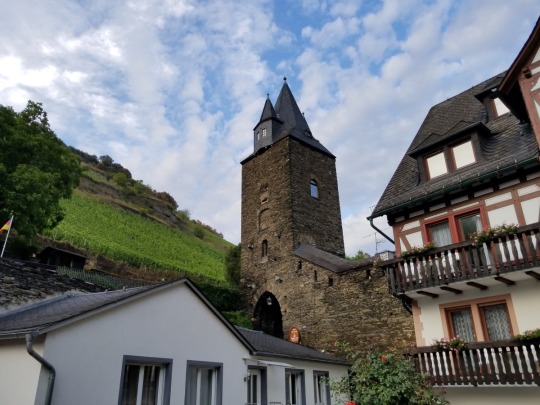
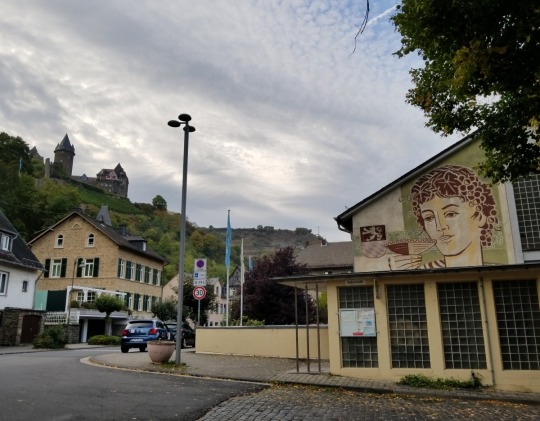
Finally, we caught the train back to Oberwesel, arriving home tired and hungry but satisfied with the day’s adventure.
—
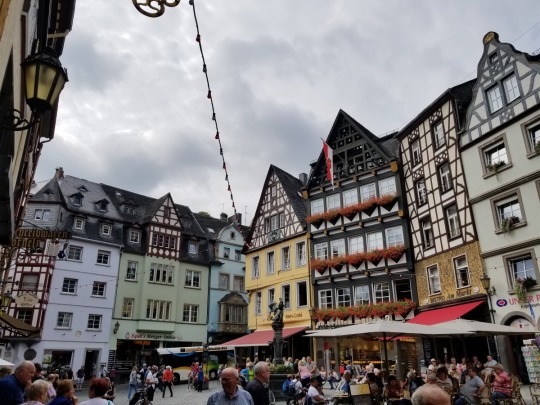
We spent the next day taking a trip to Cochem, a small town on the Mosel river known for its charming medieval architecture and abundance of wine shops. There was no question that Jessica and I had to go for ourselves. Things didn't all go quite as expected, that just meant that we got to learn a lot we didn't know about German wine tasting culture. It was a fun day, and we'll cover it in it's own post, too.
—
We had originally planned to spend the next day visiting St. Goar and Rheinfels Castle, but instead we decided to stay home and relax.
Well, we stayed home, but we didn’t do very much relaxing.
We decided to do some planning for our upcoming stay in Amsterdam, the penultimate destination of our trip. We hashed out our itinerary easily enough, but when it came to planning our transit strategy, things got very frustrating very quickly.
Public transit in Amsterdam is very easy and reasonably affordable, as long as you’re staying inside the city limits. We weren't staying that far outside the city center, but apparently it was enough to put us into a different municipality. Most major cities have transit cards or passes that you can buy and use to get cheap access to local transit and commuter trains. In Amsterdam, however, you can only get one of these cards if you're a resident. Rather than being able to use a discount transit pass like we had in many other European cities, we'd need to buy two sets of full-price tickets for every day we went into the city--one for the commuter train and one for the city transit system.
Lesson learned: If you're going to try and save money by being clever, make sure that you are actually being as clever as you think you are.
In the end, we at least managed to find a smartphone app by the Dutch rail system that would let us buy our tickets digitally--something that would prove far more important than we could have anticipated.
Anyway, all of that proved to be a headache that consumed much of our day.
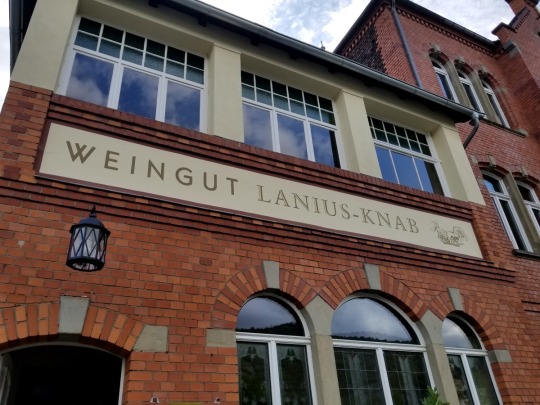
Things got better that evening, when we went to a wine tasting and cellar tour at a local winery called Lanius-Knabb. We'd heard about the place when we were first researching Oberwesel, and when we visited the TI a few days earlier, they offered to call the place up and let them know we were coming.
We showed up right on time, but the owner didn't seem to have been expecting us. He let us in, however, and we joined a German couple who were already a couple glasses into the tasting. Perhaps the information in the TI brochure was out of date, or maybe Rhine time is just a bit like island time that way.

In any case, we had a great time. The German couple didn't speak much English, but their English was still far better than our German. They seemed very nice, and we learned they were from the town of Nürburg (not to be confused with Nuremberg, which is on the opposite side of the country).
Our first two wines were Pinot Noirs--one red and one white. They were interesting, but not particularly enjoyable (at least to me). The red tasted tight and sour, while the white seemed flat and a little boring. Jessica liked the white better, since it was a bit like an unoaked Chardonnay.
Next came the dry Rieslings, which were spectacular.
Their standard estate wine was light and fruity, with light and refreshing fruity flavors that sparkle and dance on the tongue.
The second Riesling--which they called their "Premier Cru"--was even better. It didn’t dance, but it had a more powerful and cohesive flavor profile.
The third Riesling–which they called their "Grand Cru"–blew everything else away. It was rich, fruity, tart, powerful, and refreshing all at once. And the owner of the winery (who was the one giving the tasting) said that it was still too young to really appreciate. Basic Rieslings should be drunk within a year or two, but he said that this one could be cellared for around ten years before it hits its prime.
This third Riesling was made exclusively with grapes from their Oelsberg vineyard--a distinctive sideways "Y" on the slopes just north of town. We'd seen it plenty of times by then and recognized its picture instantly.

We then moved on to the sweeter Rieslings, with one half-dry, one sweet, and one late harvest (very sweet). I liked them all, but the last two were too sweet for Jessica's taste. She did still appreciate them, though, comparing them favorably to some California dessert wines that failed to reach the same level of balance and delicacy as these Rieslings.
While we were enjoying our tasting, a bit of travel stress managed to force its way back in. Halfway through, our phones buzzed to inform us that our Airbnb host for Iceland had just cancelled our reservation.
Great.
But we couldn’t do anything about it then, so we resolved not to worry about it. It also gave us an excuse to stay in town the following day as well so that we could sort everything out.
After the tasting was finished, we bought two bottles of the Oelsberg Riesling, saddened to learn that the winery doesn't ship to the US. As we'd come to expect, our German friends bought far more wine. Then, unexpectedly, they left. Which left us to enjoy a 1-on-2 tour of the cellar with the owner.
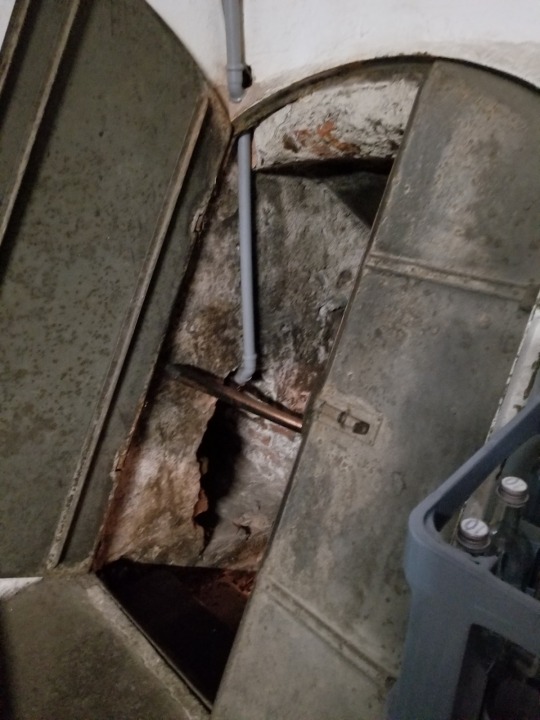
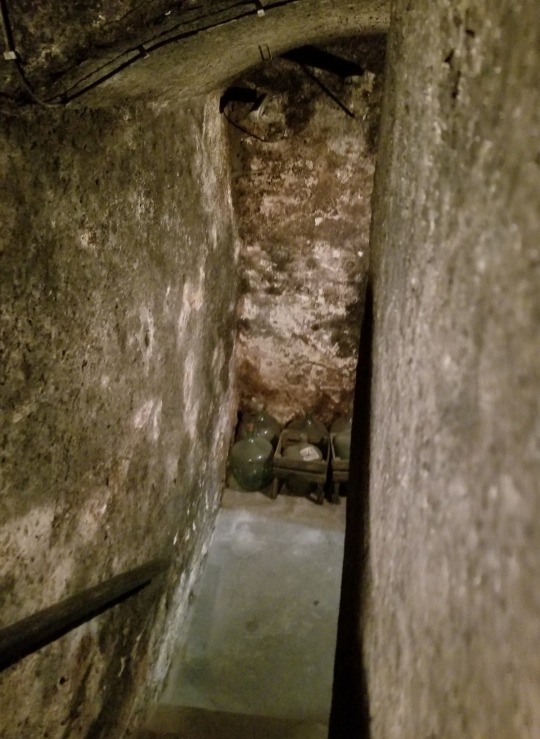
Now, you might have already noticed something a bit strange. Every other time we've done a wine tasting with a cellar tour--at home or in Europe--the cellar tour always came before the tasting. And that seems like a very sensible idea, considering all the stairs, dark corridors, and industrial equipment that one has to traverse along the way.
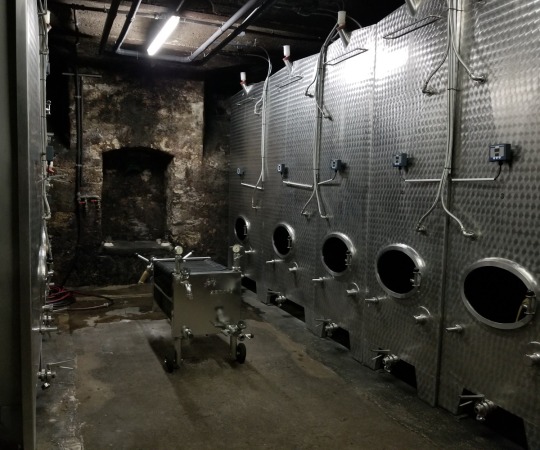
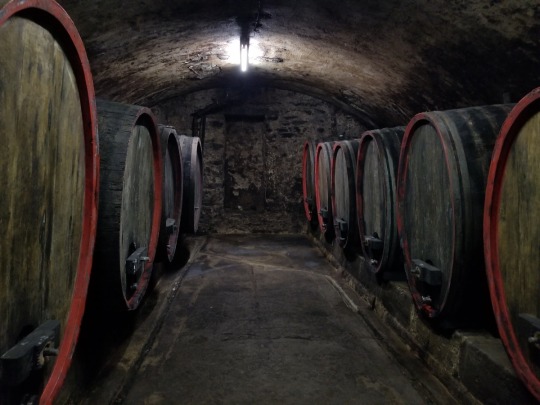

We made it through just fine, however, and we had a good time listing to the owner. He told us about his passion for winemaking and the story of how he grew the estate from one small vineyard to a relatively large operation over the past twenty-something years.
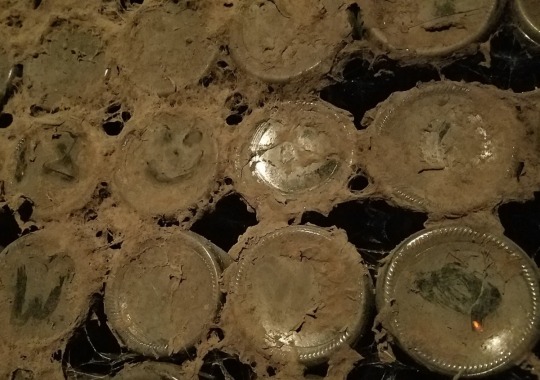
Jessica particularly appreciated how the cellar reminded us of the ones we saw in Burgundy, filled with natural dust and molds. In the States, everything is sterile. Which isn’t to say that cleanliness is a bad thing, but sterility also means lifeless. And when it comes to things like wine or beer or even milk, cheese, and bread, food is alive. Sterile food is dead food. And it just doesn’t taste as good.
Thoroughly pleased and beginning to sober, we made our way home and enjoyed a nice, simple dinner–with a bottle of wine, of course.

Such a good wine…
—
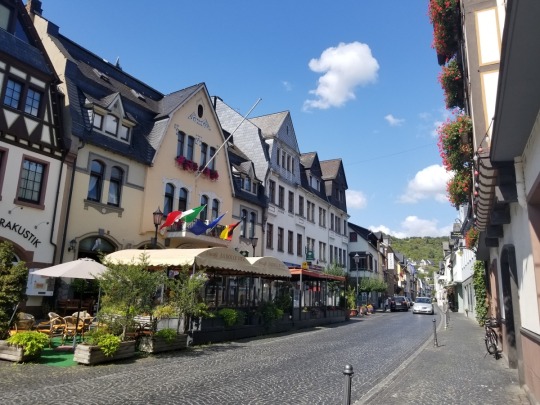
On our last day in Oberwesel--time flies!--we slept in, made a nice big breakfast, and sorted out the Iceland situation. We were able to find a very nice place that was only a bit more expensive than our original place, and we booked it.
We later learned that our original host had to cancel all of her bookings because of an emergency situation that had rendered their home uninhabitable. We made sure to tell them not to worry about us and that we hoped their situation improved soon.
While we hadn't done nearly as much sightseeing as I had originally hoped, I at least wanted see more of Oberwesel itself. Luckily, our Rick Steves guidebook had a great walk mapped out for us, starting at the market square.
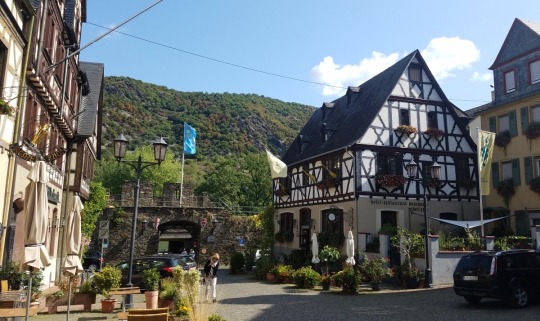
Like many towns along the Rhine, Oberwesel started as a Celtic settlement in pre-Roman times. After the Romans displaced the Celts from the European mainland, it became a Roman military base, and then a rest stop for Medieval loggers and traders moving their products downriver.
Today, the Rhine is as economically important as ever, but the diesel-powered barges no longer need to stop for a rest every few miles. The towns of the region are struggling to maintain their relevance and identity through winegrowing and tourism, but it's an uphill battle. The streets are all but abandoned on most days, and many of the vineyards lining the river valley have been left untended in the hope that future generations will have the will and resources to reclaim them.
In a way, it reminds me of all the small, struggling towns you might pass through on the old US Route 66, or any other bypassed backroads.


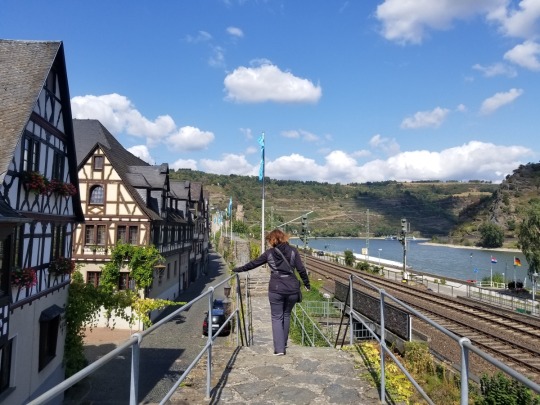
The main attraction of Oberwesel in particular is its exceptionally well-maintained medieval wall and its many surviving watchtowers--each of which has its own distinctive character.
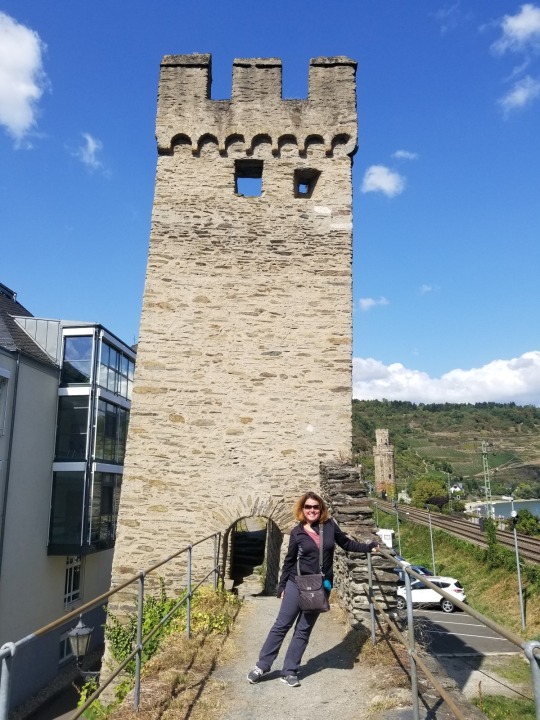
The Hospital Tower--named for its proximity to the town's medieval hospital--was built too heavy for its foundations and started to lean over like the Tower of Pisa. Rather than start over, the builders simply lopped off the top at an angle to make the roof level.
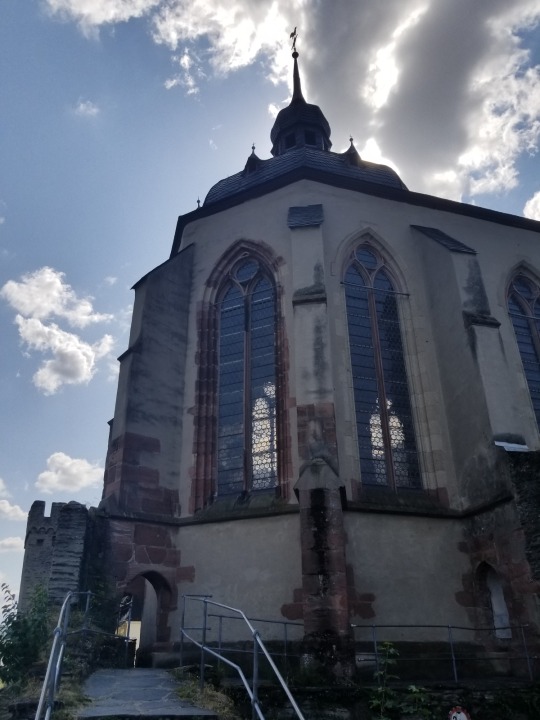

A little further down is the chapel of the medieval hospital, which is built directly into the walls--perhaps so that the guardsmen of the town could pop in for a quick prayer while on their rounds.
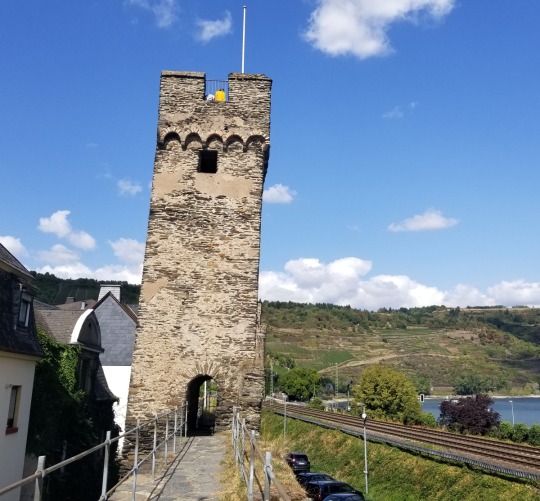
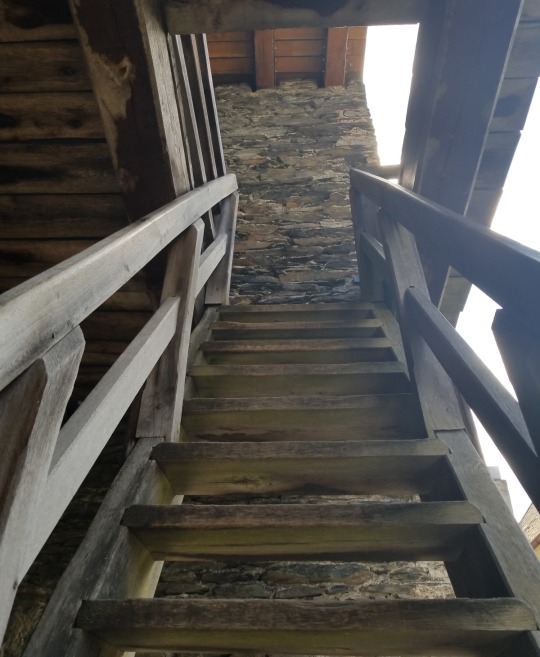
Next is the Stein Tower, named for the town's first paved road. It has a similar canter to the Hospital Tower, but this one is climbable. Steep wooden stairs carried us up to the top, where we enjoyed an absolutely spectacular view.

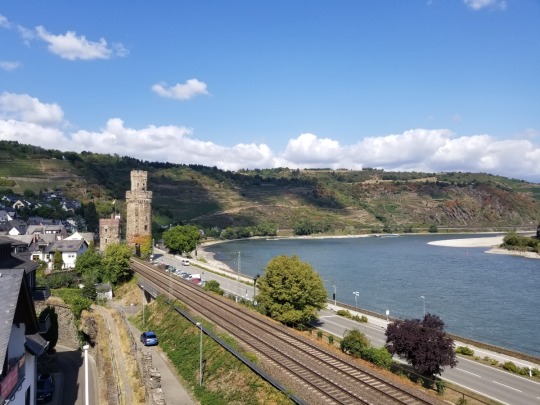

Apparently, this very spot was enjoyed by some of the most famous Romantic writers and painters of the 19th century, including Victor Hugo.


Further downriver stand the beautiful and now-inaccessible Cat and Ox towers, which marked the northwestern corner of the town.
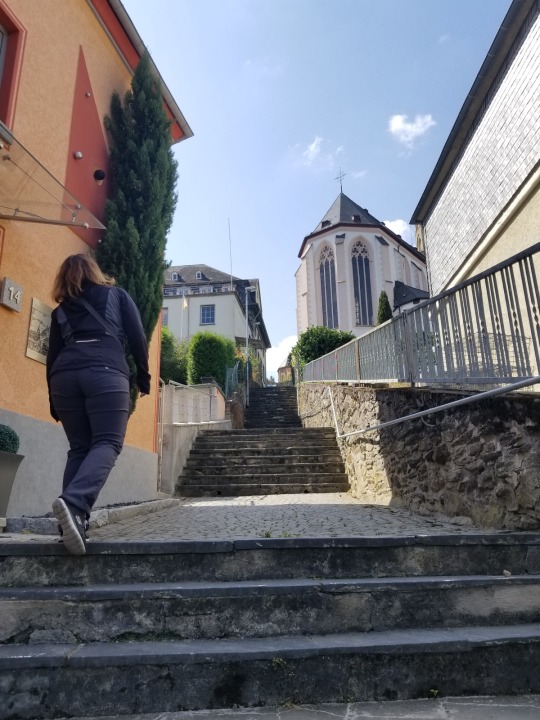
Having reached the end of this stretch of wall, we climbed down from the wall and climbed up to St. Martin's, the big white church overlooking the northern end of town.
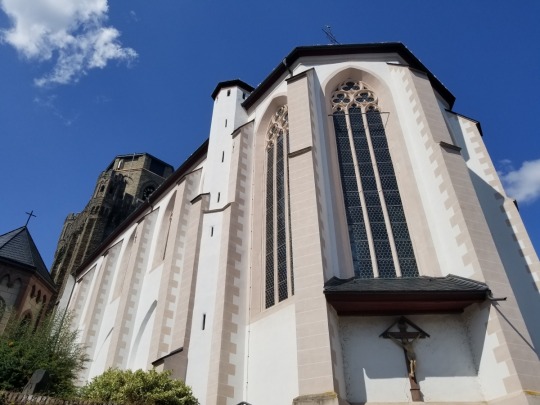
Much like Frankfurt Cathedral (which we'd already seen but will cover in the next post), St. Martin's was built from cheap local stone, then plastered over and given a clever paint job to look like it was made with more exotic foreign stones. It's ironic and a bit telling of the human condition that wealthy people in slate-rich places showed off by building in limestone, while wealthy people in limestone-rich places showed off by building in slate.
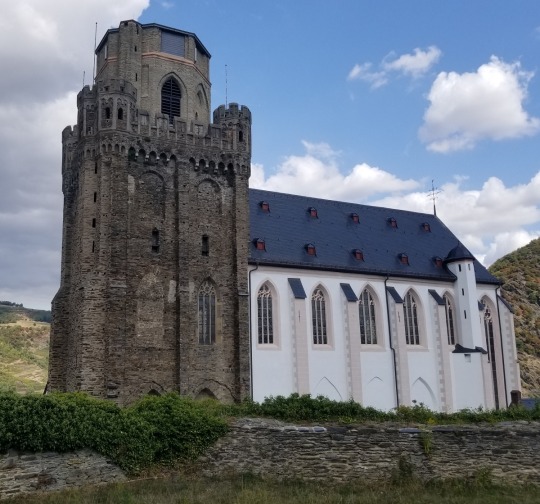
The church's bell tower actually predates the rest of the church. It was originally a watchtower along the town wall, and the locals decided to convert it into a belltower and build the rest of the church out from it.

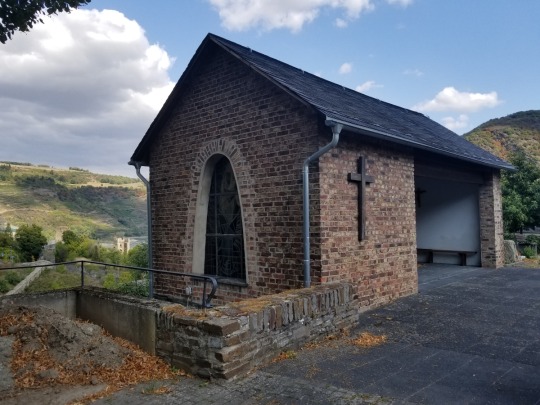

Around the back of the church is a peaceful community garden and a secluded cemetery with a chapel dedicated to the local men and boys who died during WWII.
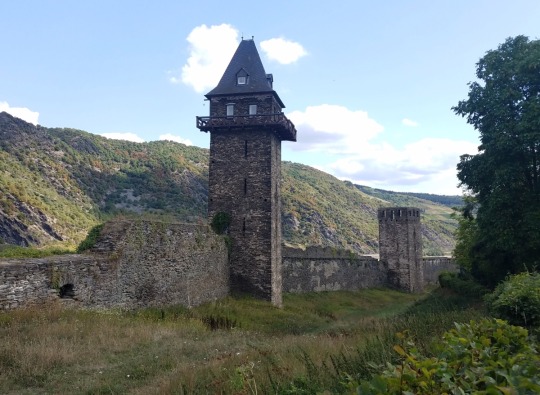
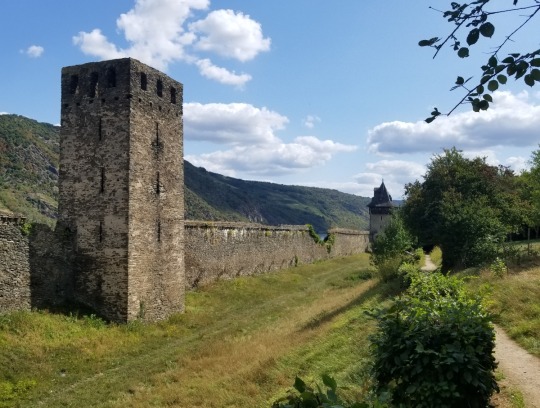
That left the western town walls. We couldn't walk on top of them, but there is a little hiking path that runs just outside of them. Apparently, the town allows people to lease the old watchtowers and turn them into houses–as long as the buyers agree to restore and maintain the tower with their own money. One of these converted residential towers even has its own drawbridge.
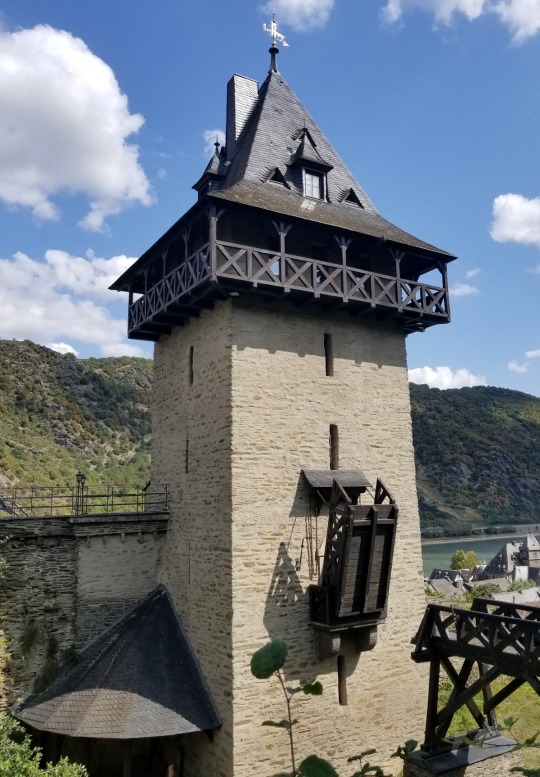
According to Rick Steves, there is a local legend about its owner's then-teenage son. When his parents were away, he threw a big party. Locals complained about the noise, and the cops showed up. Unintimidated, the kids simply raised the drawbridge and kept on partying.

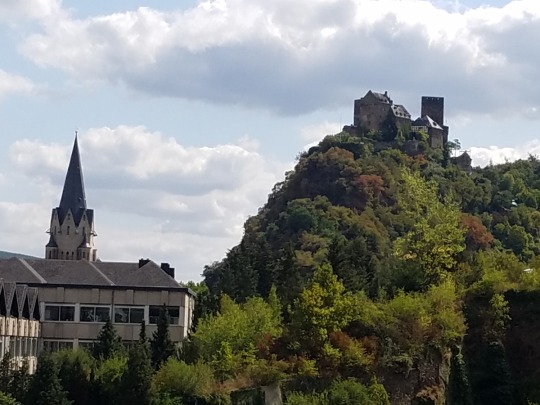
From there, it was a short walk to the end of the western walls, with some great views of the southern part of the town and the castle overlooking it all.

Back inside the old town, we peeked into a lovely little park where they shine lights up on the walls at night. There was a wedding reception going on, however, so we didn’t linger.
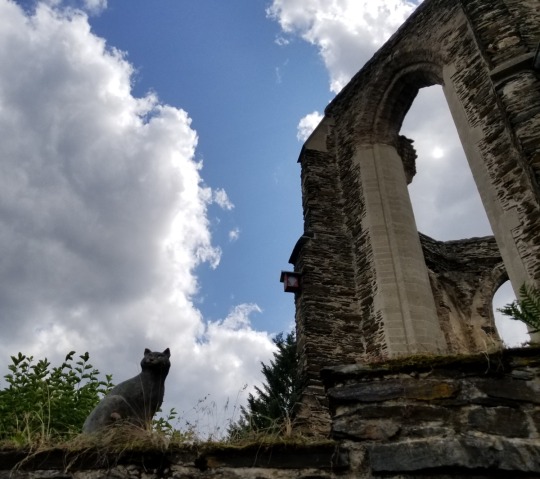
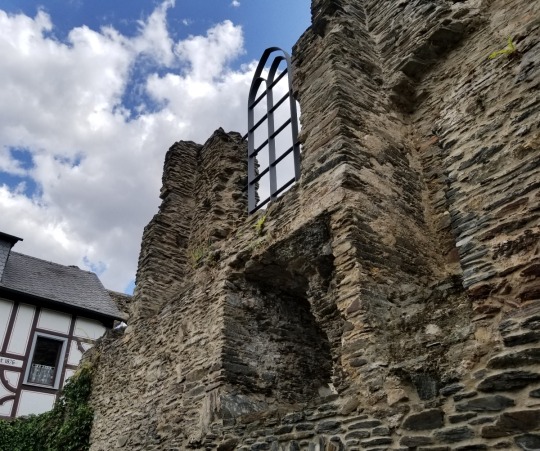

The last stop on the Rick Steves tour was the old Franciscan abbey. It was dissolved by Napoleon in the early 1800s and burned down shortly afterwards. But a couple generations later, when the local economy was suffering, desperate locals started moving into the ruins and setting up makeshift homes inside them. Local authorities have done some restoration work to expose the old abbey ruins, but the houses still stand and remain occupied to this day.

Satisfied with our day's walk, we made one last trip to the grocery store and headed home for relaxing afternoon before packing up. We didn’t get to do everything we had planned on doing in the Rhineland, but we had a great time with what we did. The Rhine isn't necessarily at the top of my list of places to visit again--unless as part of a wine tour--but I would still happily visit it again. It definitely feels like the sort of place where it's important to visit on the right days and with the right expectations.
Tomorrow, we would be heading to the Belgian coastal city of Bruges.
#180abroad#oberwesel#rhineland#germany#travel#castles#river cruise#koblenz#bacharach#cochem#wine#riesling#even travelers need days off
0 notes
Text
Wednesday February 15, 2017
CHILE DAY SIX The plan was to meet at church for breakfast at 3am, then we'd be picked up for a 4am departure to Punta Arenas for our boat trip to the penguin island. Jeff's alarm went off at 2:15 am, my back up alarm at 2:20 am! I tried not to think that it was 11:20pm in CST! But we were motivated to see the Penguins, so we dressed in our warm clothes, donned our headlamps and left the warmth of our little house. It was actually quite mild outside - a rain shower had just passed through. We saw one walker and one car during our 15 minute walk to the church (heard lots of dogs barking and passed a few sleeping). Lots of activity at the church - scrambled eggs and ham, coffee, cereal, bread, cheese and yogurt were all ready. Thought it'd be a quick bite and let's get on the bus, but it turned into our leisurely kind of meal! By 3:45am I couldn't sit any longer and got up to do some stretching. By 4am, everyone was anxious and the pastor was on his phone. Our ride finally arrived just after 4:30a, with a "no problem" to catch the boat attitude. We settled into the van and everyone fell back asleep, and soon we were there. "There" was a little shocking at first - we pulled over on the main highway and there was a dock with one medium sized boats and two smaller boats. A van with our crew arrived about the same time. I was expecting we'd go to a harbor in Punta Arenas with lots of boats - but this little dock just north of the city worked perfectly! Our group settled in and then a few more small bus loads came and filled it up, but at 7:30am we were underway. It was a great boat for this little trip. After about an hour, we reached Magdalena Island. I really had no idea what to expect, but this experience exceeded expectations! Even as we approached the dock there were penguins swimming along side the boat, as dolphins sometimes do! And then it became apparent that they weren't going to be hard to find - the island was covered with penguins! As we were walking down the dock they were swimming under it, and hundreds of others all over near the water and up near their holes (dens?). It was fun to see the groups of them standing around chanting, and others waddling too and fro. Just as our guide described, they'd cut across the path in front of you, or behind you when you'd stopped - with really no regard for us at all! It was an amazing experience. It took us about an hour to walk the roped off path up to the lighthouse and back down. Besides the Penguins, there were seagulls and cormorants on the island. There were a lot of dead juvenile seagulls, and we heard conflicting reasons for that - one naturalist said it was a larger bird that was killing them, another said it was because they crashed as they were learning to fly in the strong winds!? We also saw several sea lions hanging around offshore and the clumps of penguins seemed to move away from them. We thought it was because they're a predator to the Penguins, but the naturist said they hang around the Penguins just to get their fish, not to get the Penguins. It was a glorious day to be on the water. Mostly overcast, and barely any wind - made for super calm seas. Since it was so calm, the crew said we could go to an additional stop. We boarded the boat and headed to the island of Marta to see the sea lions. I was thinking - eh, been there done that. But I did go up to the top of the boat anyway and they were fun to watch. Kind of in clumps with a massive sea lion each ruling his harem - barking and biting and waddling along. It was amazing to see how high some of them had climbed above the sea onto rock shelves! Mellow trip back then, coffee and cookies were served and most people settled into editing their photos. As we approached the dock there was a little more commotion with the siting of a shall pod of whales (think he called them Sai Whales?) ... They had a smaller dorsal fin than an orca, but a pretty good sized tail fluke. As we got off the boat, Pastor Ariel handed us each a lunch bag, and we drove about a mile down the road to a wayside park. I'd seen the park in our drive from the airport - a beautiful spot, but terribly littered! We ate our sandwiches and peaches, mostly standing around the table. Then for our Punto Arenas adventure, but I was asleep before we even passed the airport. When I awoke, we had a 20 minute stop to "shop" at a mall designed for cruise ship passengers - not the kind of shopping most of us had in mind! Back on the bus - back to sleep. The next time we stopped was on a beautiful overlook with a view of the city and the sea. As I took in the panorama, I looked to my right and saw a vendor selling locally knit products - I looked left and there were three more! Now we were talking. I found a fun hat, but as I was looking further, I found the alpaca poncho I'd been searching for - my only quandary was deciding which color - I settled on a bright blue - the color of the ocean! Back in the van and we drove to the main square and finally got the sense that Punta Arenas was a pretty big city - after less than a week in Puerto Natales all of a sudden I felt like a hick coming to the big city. The shoppers in the group set out to explore some more artisan booths that were set up along the square, while the cultured ones checked out the cool statue of Magellan in the middle of the square. Back in the van for a stop along the shore, and then one more quick stop at a statue of a shepherd complete with sheep and sheep dogs. There was a live dog napping there that reminded us of Cody - darker color, but similar build and same cute way that one ear was bent over. Back in the van for a quick stop at the central Methodist church. We were greeted by the UMW lady and the OB doc that we'd met over the weekend (I have no idea of their names). It was fun to see a photo on the wall of Pastor Don, Coggin, Glen and Heinz from their trip here 4 years ago! We sang a song and had a prayer, then back in the van for a trip to their smaller mission church on the hill. There we were greeted by our "old friends" Aurtero and Pepe, along with about 6 woman. We gathered in the sanctuary and they sang a "welcome" song to us, then we went to their kitchen for tea, sweet breads, empanadas, and tea sandwiches! It was fun, and yummy of course. Climbed back in the van one last time just before 5pm - most fell promptly asleep again. After about an hour, we came to a sudden stop and the driver insisted we get out and take a photo?! Sign said "road to the end of the earth" so we were told ... We arrived back in Puerto Natales about 7:30pm and dinner was waiting - mussels (biggest shells I'd ever seen served), chicken, ham, pea pods, potato pancakes, and sausage - along with wine tonight. Glorious meal to end a fabulous but long day. We walked back to the house and arrived just before Celio got back from helping at the church. We had a break through in our communication tonight - not necessarily with our words, but with our understanding each other. We showed her the photos of our day, and she toured us through her garden outback. Awesome day in a fabulous country!
0 notes